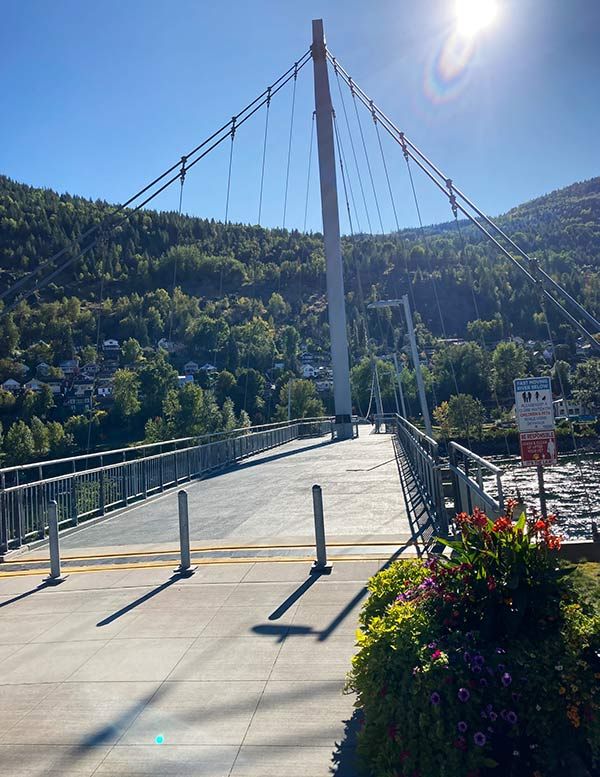Photovoice in an Early Childhood Educator Professional Development Program
Understanding the Program Experience from the Participants’ Voices
Jessica McQuiggan, Kemi Odegbile, and Courtney Lord
March 14, 2024
Funded by: Women and Gender Equity Canada | Femmes et Égalite des genrés Canada
Commissioned by: Early Childhood Educators of BC (ECEBC) Leading In A Changing Environment and the SRDC
The Leading Change program was designed to amplify the voices of British Columbia’s Early Care and Learning (ECL) sector to ensure their full participation in local, provincial, and federal decision-making. This initiative recognizes that frontline perspectives are essential in developing a responsive and sustainable ECL system in BC. Implemented by the Early Childhood Educators of BC (ECEBC) in 2022 to aid in COVID-19 recovery efforts, Leading Change recruited 36 Early Childhood Educators (ECEs) from across BC to participate in the program. ECEs from groups underrepresented in leadership positions were especially encouraged to apply.
Participants gathered over an 18-month period via monthly online Community of Practice sessions, with an intent to engage in collaborative learning, knowledge sharing, and systems-focused planning. Throughout this timeframe, participants were supported to develop and implement an “idea for change”. By gathering the voices of their peers and communities, participants built their confidence, skills, and knowledge, and created opportunities to share their expertise with decision makers. Ultimately, participants developed and implemented 22 community change projects across the province (see page 44 for project descriptions).
Leading Change and Photovoice
Photovoice was used at the end of the project to help document the participants’ experiences in their own words. Photovoice is a participatory research methodology with three main goals: (1) to enable people to record and reflect their community’s strengths and concerns, (2) to promote critical dialogue and knowledge about important issues through large and small group discussion of photographs, and (3) to reach policymakers 1 .
This flipbook both documents the Photovoice activities and celebrates the process and progress of the participant journey through Leading Change.
1Wang, C., & Burris, M. A. (1997). Photovoice: Concept, methodology, and use for participatory needs assessment. Health education & behavior, 24(3), 369-387.
One of the strengths of Photovoice is the ease with which it can be adapted to suit the context; thus, there is no single “correct” way to conduct a Photovoice project. This project consisted of three general phases: orientation, photography, and discussion.
Orientation: In September 2023, Leading Change participants were invited to a Photovoice orientation session, hosted online by the Social Research and Demonstration Corporation (SRDC). During the 60-minute session, the Photovoice method and basic photography techniques were reviewed, the framing questions for the project were introduced (see below), and the ethics of taking photos were discussed.
Photography: Over the following 2.5 weeks, participants took photographs in response to the framing questions and developed titles and short narratives to accompany them, which were submitted to SRDC online.
Discussion: In November 2023, Leading Change participants gathered in-person at a two-day meeting to commemorate the end of the project. During this meeting, three groups of about nine educators each discussed photos and narratives from each framing question. Over approximately three hours, Photovoice participants presented their photographs (which were printed on 8x10 photo paper and gifted to the photographers to take home) and described the message they wished to share. SRDC researchers facilitated group discussions based on these prompts, and noted themes from the discussions related to the project.
Four framing questions were developed by SRDC researchers. These questions were designed to guide the reflections of the participants about their experiences in Leading Change and their professional development as ECEs. Each participant selected one question from section A and one question from section B to help ensure an approximately even number of responses to each question.
A. What picture would you take to…
- Showcase ECE leadership in the early care and learning sector?
- Show how your work-related activities have changed since enrolling in Leading Change / highlight the key takeaways from the Leading Change program?
B. What picture would you take to…
- Demonstrate what being an early childhood educator means to you?
- Share an important message about Leading Change with decision-makers (e.g., program developers/administrators, funders, licensing officers, etc.)?
Findings
This section showcases all 29 photos and narratives that were discussed in the groups. As much as possible, the participants’ narratives have been maintained exactly as provided. Minor edits were made for clarity and to correct typographical errors and shared with the participants in advance of publication to ensure that their perspectives continued to be reflected accurately. The main themes from the discussions are provided along with the photos and narratives for that framing question. Participants’ Leading Change projects are also noted at the end of each narrative.
This question was designed to set the context for the data collection. As Leading Change was co-designed by participants, they helped shape the course content to suit their needs. Thus, reflecting on “your why” was an important step in the Leading Change process. Recognizing that this question is deeply personal, the responses help to showcase the participants’ values and principles and set the stage for understanding some of the motivations for engaging in Leading Change.
While the meaning of “being an early childhood educator” isn’t the same for everyone, thematic analysis of the discussion showed consensus around being a strong foundation for the next generation, and the importance of setting up children for success. Participants see ECEs as an “extension of children’s families”, and an essential part of the community. Guiding future generations is not a role they take lightly; although it sometimes feels like a thankless and forgotten job, early childhood education is essential to children and society. It is as much a passion as a profession for the participants in this program.
This drum circle represents us - diverse educators with unique styles and perspectives. Like these drums, we shine brightest when we unite in harmony.
In teaching and caregiving, consistency is key, just as the right tempo is for the drums. Each of us plays a unique role, like different drums in the circle - some provide a solid base, others add diversity and flair, and one leads the way.
Listen and learn from each other, as the wisdom of the Elders guides us. Strength lies in unity, and by supporting each other, we set a rhythm for others to follow.
Our passion, dedication, and commitment drive us. When we sync our hearts and unite our beats, we create something magical - a song of hope that resonates across our sector.
Think of this photograph as a reminder that we’re part of a circle celebrating diversity, embracing unity, and singing a hopeful song for the future. With our hearts tuned to the same drumbeat, we’re ready to face challenges and create a brighter tomorrow.
Let’s beat together, keep the rhythm alive, and continue to inspire, nurture, and educate. Together, we create a symphony of hope that echoes far beyond our classrooms.
Project #15: Seeds of Hope
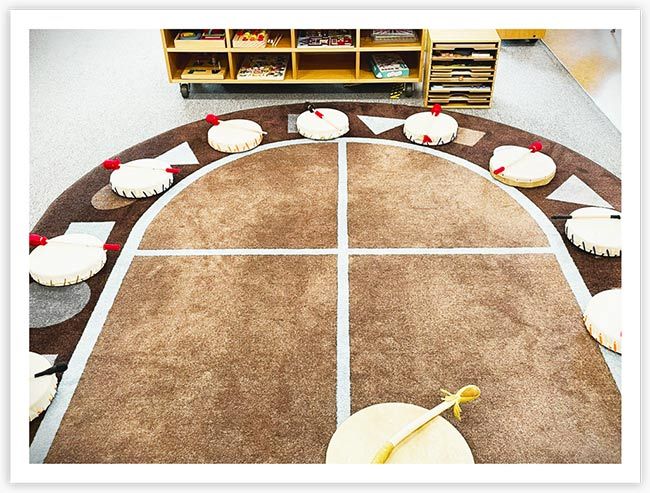
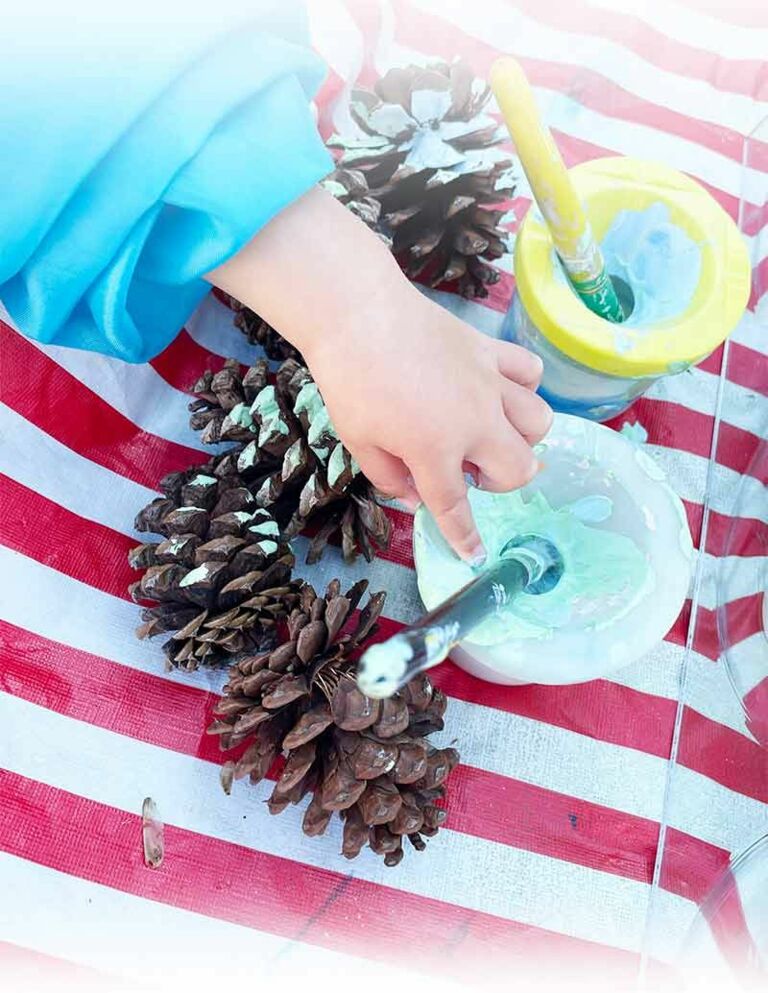
I get up each morning and show up for these little hands. I hold onto them on walks, I wipe them after meals, I watch them put on slippers and turn the pages of books. I will watch them grow.
Being an Early Childhood Educator is a job filled with responsibility and joy and stress and wonder. It’s hard and frustrating, especially in today’s world. But these little hands — they encourage me to advocate, question, challenge and continue learning. Maybe we will see change in our sector by the time these little hands are holding little hands of their own
Project #3: Mentorship Initiative for ECE Dual Credit Students
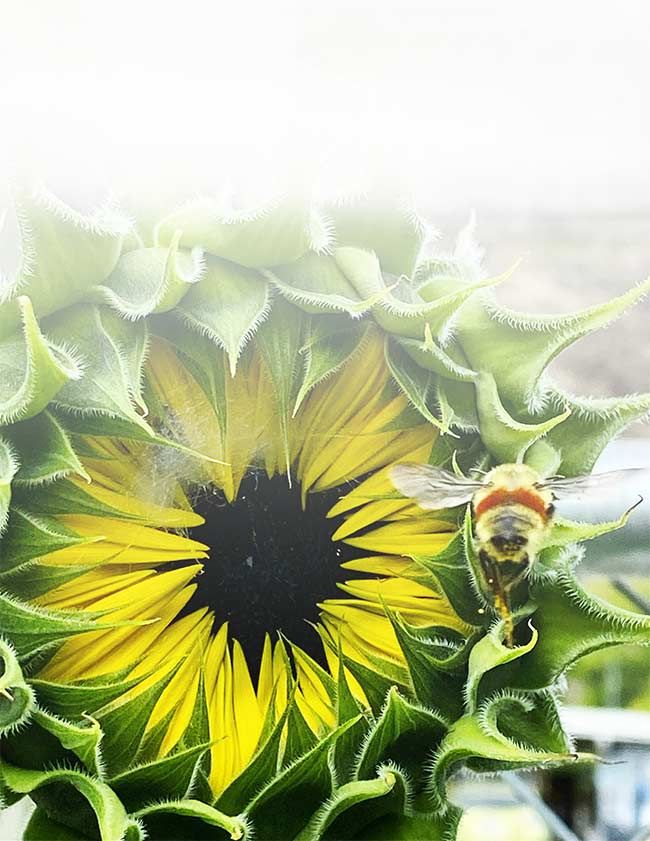
[It is sometimes thought that a] bumblebee scientifically cannot fly. Their bodies are too big and the pollen that they carry is too heavy for the small wings they have. The bumblebee continues to fly because nobody told the bee it can’t.
A bee has such an important job in our eco-system. If the bees quit we would not have many of the foods that we love and need for our health. If the bees quit our world would not be as beautiful.
Being an ECE in our current society is like being a bumblebee. We take for granted the work the bee does until the bee doesn’t do the job and then we can clearly see the repercussions of its important role. Sometimes being an ECE is a thankless and unappreciated role to be in. I know how important and priceless my role is in our ‘eco-system’ but does anyone else??
The work we do is fundamental to a strong, healthy, growing community. The work we do should be held up and honored because without it our world would be very different for everyone.
We are a strong group of dedicated ECEs who like the bee don’t listen when the world tells us it is too heavy, too much or too hard.
Project #21: Possible Pathways for Educators
Being an Early Childhood Educator means being so many things to me, one of them being not just one who aspires to inspire, but one who actually does each and every day, in not only the work that they do, but also in the way that they are.
The Leading Change journey has built my capacity to grow as the pedagogical leader I hope all ECEs see themselves as. I hope our project has inspired others, just as they inspire us each and every day with the work that they are doing. We wanted our participants to see themselves as the important makers of change that our sector needs/wants more than ever. We know there are many challenges in the sector, but may we continue to be the change that we need/want to see in our collective and shared vision, for our image of ourselves as ECEs is important to our image of the children and families we work with, as they go hand in hand and are interconnected!
Project #4: Finding your Why: Reigniting your Passion
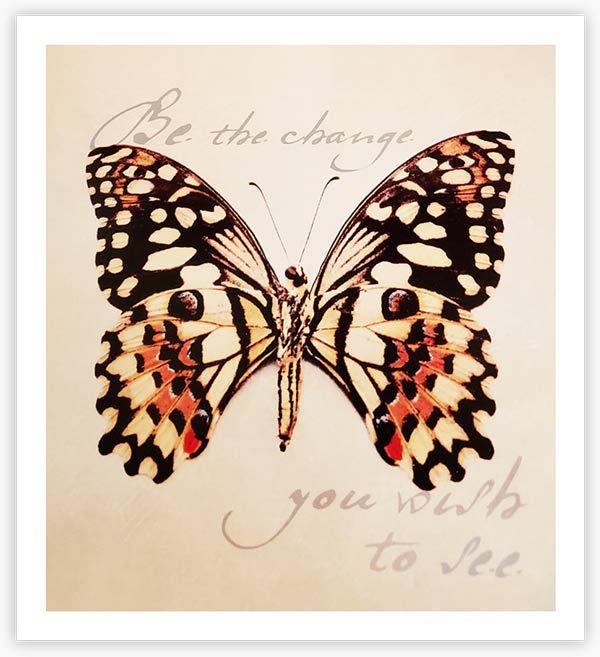
Photovoice participants discussed how ECEs facilitate belonging and a sense of community where everyone has the confidence to be themselves. Feelings of belonging can be transformative for children and families. The photographer of this picture described implementing a parents’ circle in their Leading Change project to bring them together and ensure families and children know that they belong.
Participants also reflected how it is important for ECEs to feel that they belong in spaces where early care and learning policies and decisions get made. Representation is a key part of belonging. Participants expressed the importance of being at decision-making tables, so that other ECEs coming up behind them see that they can also have a seat around the table.
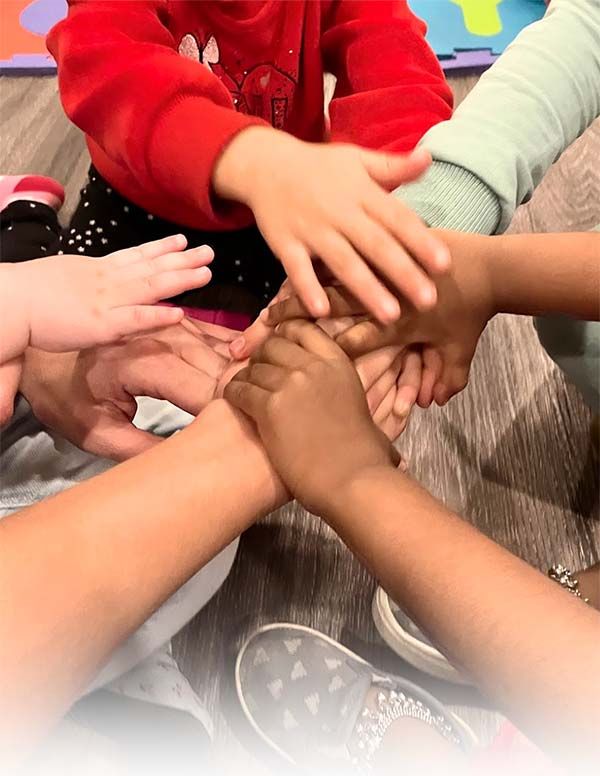
Belonging is a basic human need; it provides us with a sense of safety, community, confidence.
Project #17: Immigrant Voices in Early Learning
Being an early childhood educator means having a big heart to nurture diverse young minds. My community is surrounded by woods and gardens, making it an ideal location for early childhood education. We can take the children into nature, allowing them to explore and play amidst diverse plants and rocks.
Project #14: Voices of Immigrant Child Care Professionals
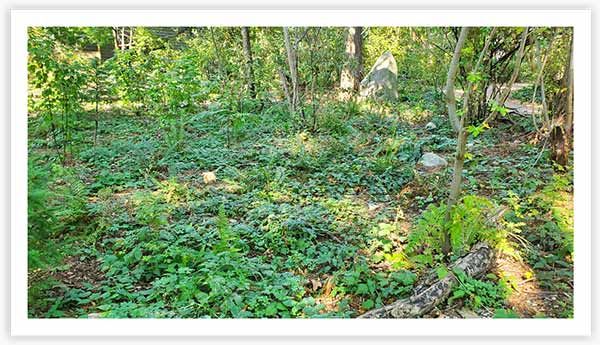
Participants discussed the importance of modelling or demonstrating positive change for the children in their programs. Being out on the land is one way of doing this, such as learning from plants how to co-exist and depend upon one another. Tending to a garden and caring for plants allows children to develop love and respect for other beings as well as the land that nourishes us.

A picture of a heart is a picture I would use to demonstrate what an early childhood educator means to me. ECEs have giant hearts that give to all. They are some of the most selfless, caring, giving and loving people. We love the children in our class like they are our own and try to provide them with the most stimulating and educational environment.
Project #3: Mentorship Initiative for ECE Dual Credit Students
This question elicits examples from the participants’ perspective about what they do differently in their ECE practice, based on participating in the program. It is important to provide space to share both anticipated changes as well as unintended consequences of the program; through this question, participants can share the most impactful changes in their personal and professional lives.
A major theme in this section was that Leading Change helped empower participants to see themselves as skilled professionals whose knowledge of child development is valuable and essential. Many participants now see themselves as advocates and changemakers that belong at decision-making tables. The program often pushed participants outside of their comfort zones and into places of growth, resulting in different mindsets, behaviours, and perspectives.
The Columbia River Skywalk is a landmark in my city. It was recently built and connects my neighborhood with the downtown core. Walking over the river is a very grounding experience for me personally. I enjoy watching the water levels go up and down.
I often observe the goings on of the river with the children that I care for. We talk about which way the river is moving and what may be floating or swimming in the river that day. Sometimes the currents in the river look ominous and deadly and other times the river sparkles with the morning sun. Sometimes when walking over the bridge it gets windy and it feels like sailing on a boat or ship....This bridge brings much joy! This bridge may seem like just a bridge to some, but for my little friends and I, it is a journey of limitless adventures.
I chose to re-open my home facility this past year when I was feeling defeated. Now my work gives me endless energy again.
Project #20: The Joy of Child Care
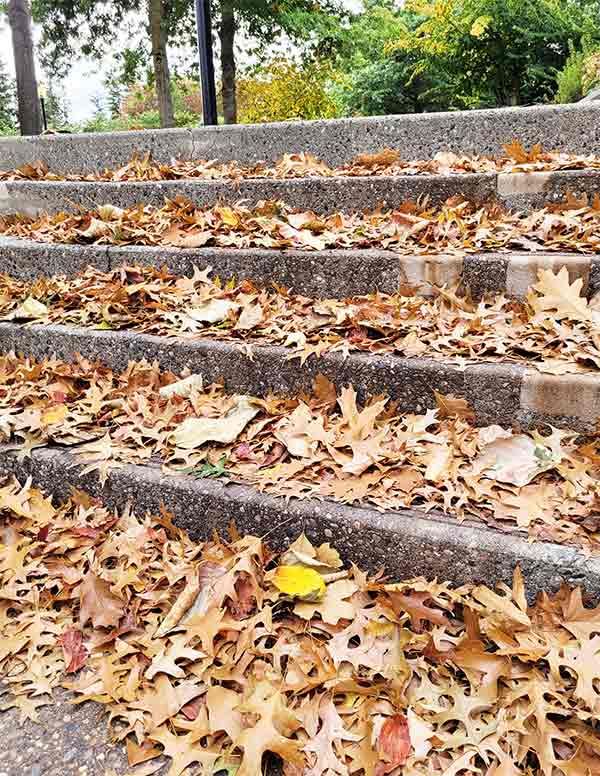
My journey with Leading Change has been one of seasons. Seasons full of sunshine and seasons full of storms. It’s been dark and it’s been bright. Happy and sad. Joyful and frustrating. Celebratory and stressful. When I saw these steps, leading up to the incredible lecture I was about to attend, I was excited to see the leaves, representing another season of change. I reflected on the past year and a half and thought about all that’s happened and I am truly grateful for it all.
Leadership isn’t linear. It can be stormy and it can be calm. Advocacy can be challenging and it can be triumphant. Networking and building relationships can be positive and it can feel intrusive. Each journey has it’s seasons, how you travel through them is up to you.
Project #3: Mentorship Initiative for ECE Dual Credit Students
This Photovoice participant shared how their practice changed after reflecting on their roots and wanting to reduce the amount of food waste produced by their ECL program. Rather than preparing all the food available to the children each day, this ECE empowered the children to lead this process. Together, they prepared small amounts of food and then decided whether to prepare some more or to save it for another day. In addition to reducing food waste, this practice helped children to become more in touch with their own bodies and exercise autonomy — important life skills.
Although this took longer than preparing the food for the children, it was time well-spent and became part of a meaningful morning routine. The participant shared that they initially struggled to convince their colleagues to join in this practice. Leading Change helped participants to reflect on their values and accept that different educators have different roots, and this acknowledgment can bridge gaps in understanding between colleagues.
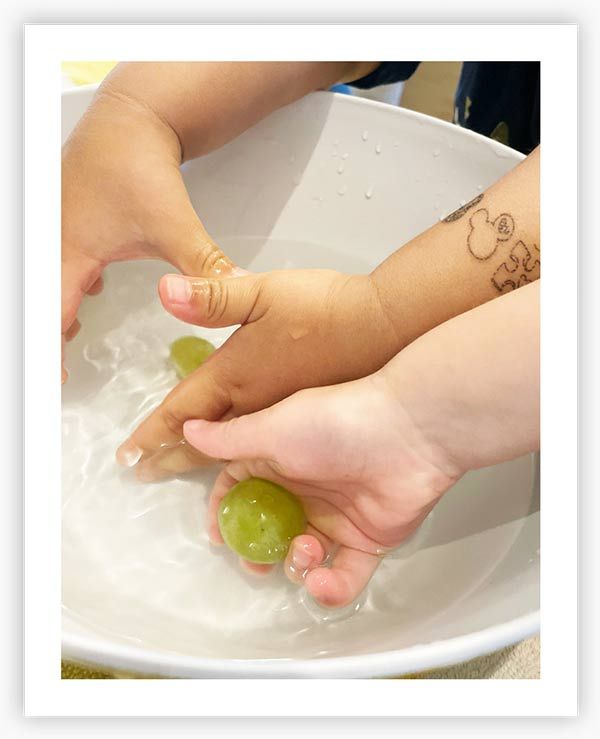
Our actions will always give a message to children. We need to see them as capable and future leaders of the change our world needs.
Project #13: Re-connecting with your Roots
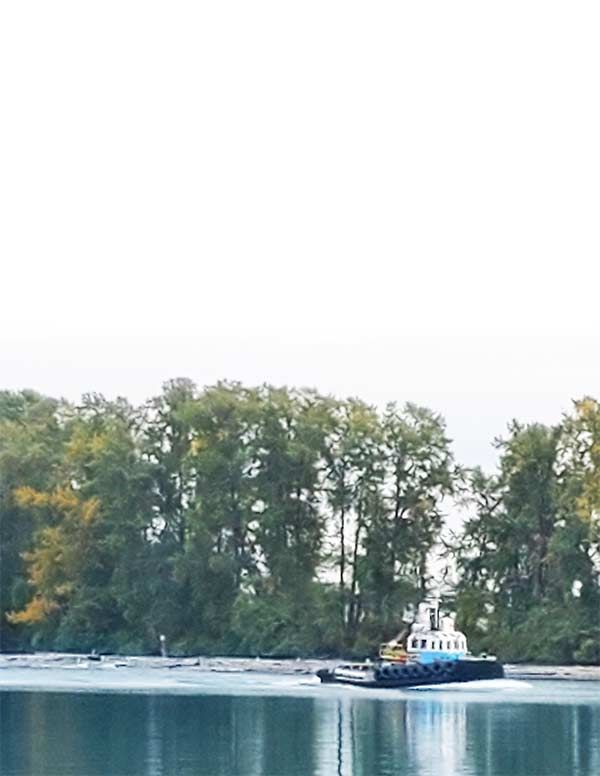
A small tugboat can easily pull thousands of tons across a body of water. It can accomplish this despite its smaller size due to its huge engine and propeller.
The Leading Change program allowed me to feel like a tugboat. Through our project, we hope to be able to pull lots of immigrant childcare professionals (logs in the photo) toward a better future.
Project #14: Voices of Immigrant Child Care Professionals
This Photovoice participant described how their Leading Change project led to ripple effects in their colleagues, centre, and community. They began by putting up posters related to Truth and Reconciliation, which organically spurred momentum among other educators in the program, who added to the display. Over a year and a half, it became part of their practice to share information through conversations and workshops. Sparking this change and seeing what it grew into was personally meaningful for this participant. The importance of starting a process to create change — building on each small step, creating ripples that join to make bigger waves of change — was a theme that arose in the discussion groups. Taking the time to pause, reflect and focus on the steps towards change was important to achieve the desired results.
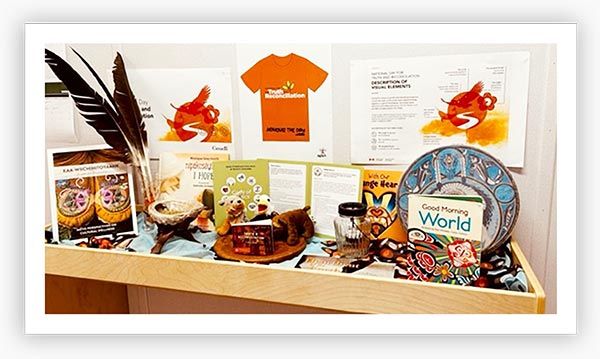
Sharing our knowledge and our gifts together to express our commitment to making positive change.
Project #16: Growing Relationships and Connections to the Land
When we collaborate with each other, the process often turns out differently than we might have expected. Many minds, viewpoints and skills blend together. As we take action in both collective and individual ways, we can discover and celebrate the strengths and talents of both ourselves and our teammates.
During the Leading Change program, exploring in this way has improved my confidence in my professional voice, and has furthered in my ability to engage in deeper dialogue with my colleagues, ELC students, children, and families. I have been reminded just how political our work is, and have felt empowered in my advocacy.
Project #6: ECEs for Inclusion in BC 20
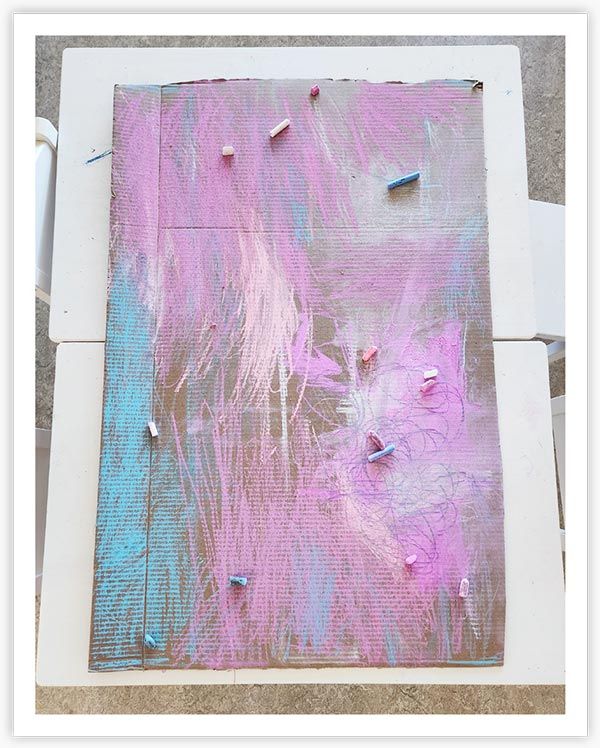
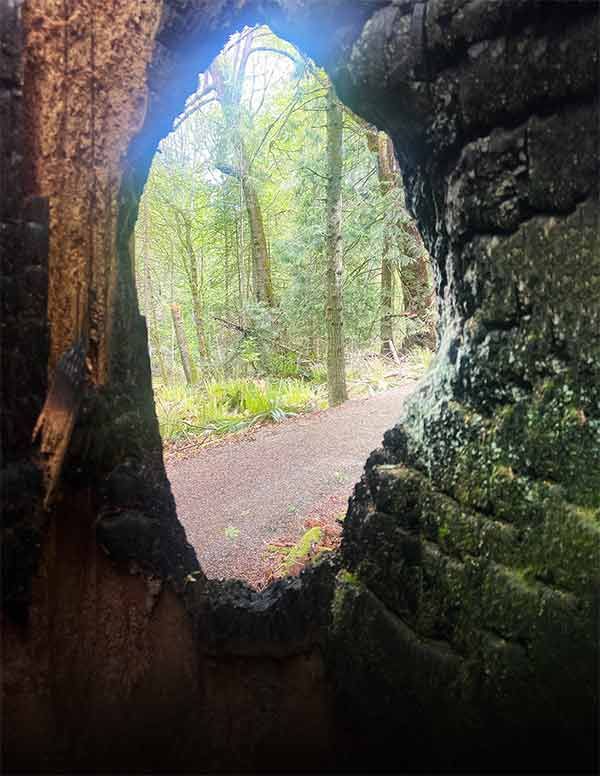
Looking at different perspectives, listening to many voices, seeing in new ways: keeping the smoke hole open. What needs to change? To deepen?
Project #17: Immigrant Voices in Early Learning
A common theme throughout the Photovoice discussion was the concept of reflection and self-discovery. Educators shared how embracing their story was an essential piece of developing a change project. Because they were given time and support to work through this important process, rather than needing to show up with a fully-formed idea, they implemented projects that were deeply meaningful and motivating. Being inspired by others’ stories and teachings helped them understand what drove them in their ECE work.
Leading Change gave me the opportunity to learn a very important lesson. Leading Change made me look within myself, finding my strength, my vulnerability and find my story. My first draft of my document was the opposite of all those things. I made a lot of suggestions, I did a lot of telling in a different way. Thankfully I listened to some feedback from some trusted friends. I had a therapeutic cry and then I told my story. The important message I was given that I repeated to myself through this process is: We are an inquiry-based learning model, we only learn through other people’s stories. Everyone has a story to tell that can lead to change. Everyone has a lived experience that can spark ideas for charge. We need new heroes and new stories. Leadership can be telling your story. I put my story on paper and sent it out to others who wanted to learn or gain ideas from it. Their feedback and the community that was built has been the highlight and the lasting takeaway.
Leading Change afforded me the opportunity to create this document, tell my story and create a lasting community of connection and collaboration.
“The deepest learning takes place through lived experience. It requires exploring our identities, learning from our mistakes, and having gratitude for our gifts.”
- Aboriginal ways of Knowing and Being - BCTF
Leadership can be telling your story.
Project #21: Possible Pathways for Educators
Leading Change aims to build leadership skills, acknowledging that leadership can take different forms in different settings. With this question, we get to hear participants articulate how leadership looks like for them.
Some common themes arose across the diversity of ways that leadership can manifest. As well-connected community members, participants demonstrated their leadership by identifying and bridging gaps in misunderstanding of policies and practices related to early childhood education. Within a complex and changing landscape, they are able to articulate the issues that impact children and families, as well as advocate for themselves, their colleagues, and their communities.
Through finding their voices, participants asserted that ECEs need to be more involved in shaping the policies that impact their work. This can be achieved by making connections within and outside of the systems in which they work, such as in schools and municipal and provincial governments.

Leadership as an ECE reminds me of a river. It is strong, adaptable, and loving. It moves where needed and gives space where needed. It gives to all and takes very little. Rivers are strong and resilient, much like an ECE, changing with the environment with grace and love.
Project #2: Connections through Self Compassion
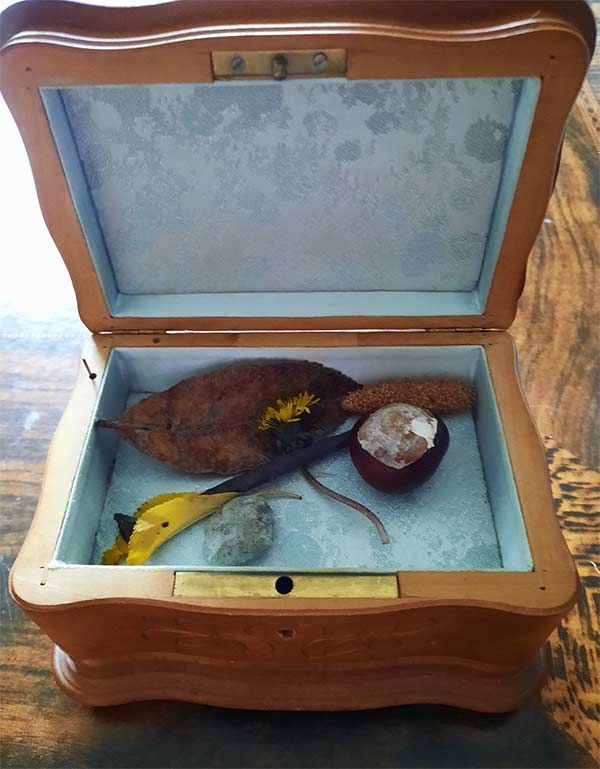
This photo to me represents the caring and loving kind of leadership demonstrated by ECEs. Our leadership is in part to show the world the importance of what we do when others do not always see it that way. These items are treasures, children have nothing and see something beautiful and give it away to show their care.
While others may see only a leaf, educators see a meaningful gift.
Project #6: ECEs for Inclusion in BC
This picture captures a moment in my beloved community, Champlain Heights. Each day, as I round the corner of the triangle grass area, my curiosity is piqued, hoping to discover new painted rocks. This scene embodies the essence of the following quotes:
“ECE leadership is manifested in our actions, inspiring others to dream more, learn more, do more, and become more.”
“Together, we can craft a world where everyone feels connected and supported.”
Project #14: Voices of Immigrant Child Care Professionals
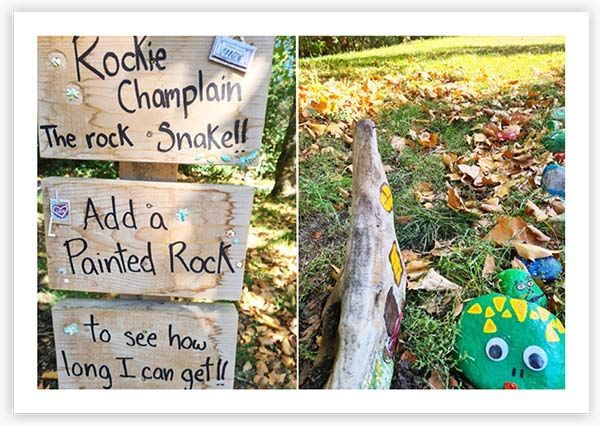
I chose this photo of these rocks because it serves as a powerful symbol of the importance of leading the way for change in my role as an early childhood educator.
The larger rocks in this image stand out, forming the solid structure of an inukshuk. They represent the foundations we lay in the lives of the children and families around us. As educators, we have the incredible opportunity to create a loving and supportive structure that inspires these young minds to envision a future filled with hope and positive change. Just as the inukshuk provides stability, we can provide safety and structure for the children we care for.
But it doesn’t stop there. This image also reminds me of how educators can come together, just like the rocks forming this structure, united for the betterment of our sector. By standing together, we can uplift those who are yet to join our profession, ensuring that they enter a field that is committed to making a difference in the lives of children and families.
I took this photo during Truth and Reconciliation weekend, and it holds a special significance for me. It serves as a powerful reminder that it is our generation that has the responsibility to lead the way toward a better future for Indigenous communities. It is a call to action, a commitment to honor the memory of those children who were lost, and a dedication to forging a brighter path ahead.
As early childhood educators, we have the privilege of shaping the minds and hearts of the next generation. Let us be the guiding rocks, the sturdy inukshuk, that help them find their way to a future filled with hope, change, and unity. Together, we can build a stronger, more compassionate world for all.
Project #15: Seeds of Hope
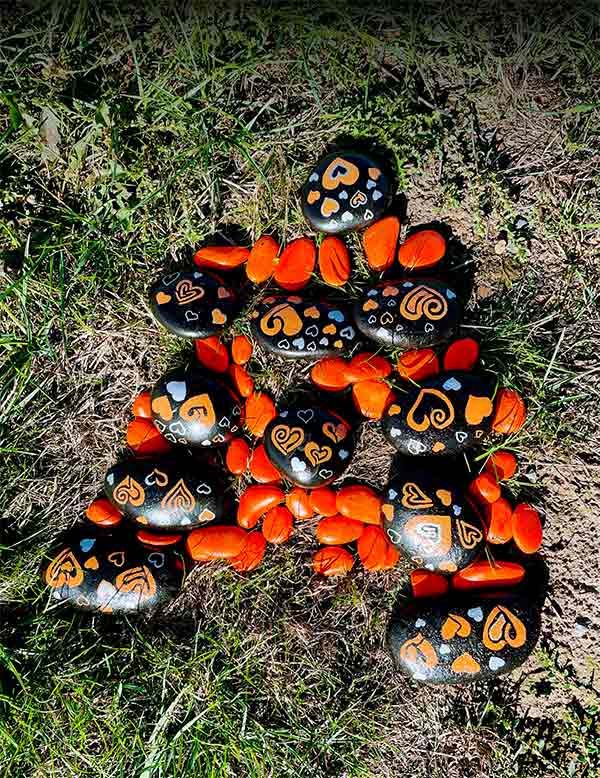
This is my neighbor’s house. Not only do I enjoy looking at the bright colours of her peony flowers, I also enjoy watching my neighbor interact with others. I have watched as she cuts her flowers and creates lovely bouquets for others. I see how my neighbors are consistently helpful to each other by bringing food, or giving rides to appointments and taking time to visit with each other.
My neighbor always waves at me as I walk up the sidewalk with my quad stroller. I am so grateful for my neighbors because they make my neighborhood feel like a safe haven. Role models such as my neighbor inspire me to be kind above all else.
Project #20: The Joy of Child Care

I took this photo at the start of the Leading Change journey aspiring to be an ECE leader in the early care and learning sector, hoping to not only inspire others, but also to feel inspired myself! This journey began with taking a chance and trusting the process, gaining and sharing so much inspiration throughout. If the commitment, dedication, and passion is there, you can do so much to inspire others and it is the inspiration we get from others that keeps us going to try to be better and do the best that we can.
Remembering our why helps keep our goals in focus, so that we can keep growing and learning and be the pedagogical leaders our sector needs!
Project #4: Finding your Why: Reigniting your Passion
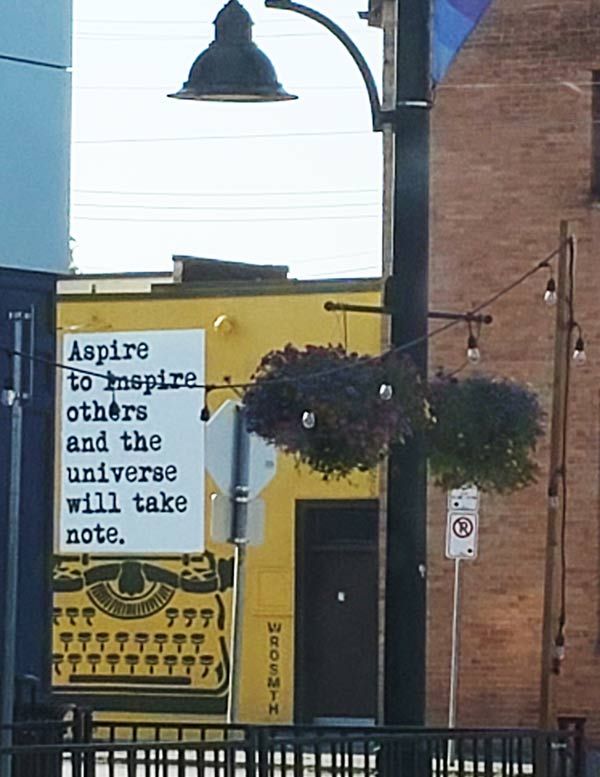
The early care and learning sector anywhere and everywhere in the world, ultimately builds a road TO the future FOR the future. The ECE leadership in the sector plays a fundamental role in raising and shaping the future of the nation of our country. Building this “road” is a constant, never-ending process and requires innovation, appropriate equipment, workforce, and time. Just like in the ECE field, in building a road there are many factors and many people involved. There are developers, engineers, equipment operators, road workers, and many more. They all play an equal and significant role and have unique gifts, talents, and skills to contribute.
Building the “road” TO the future FOR the future also requires constant maintenance, improvements, and expansion in the ECE field. The ECE leadership starts with identifying these factors and recognizing ALL being involved. “ALL” means the ECEs working on the floor, managers, owners of ECE businesses, policy-makers, the community at large, and the government.
The ECE leadership starts by understanding (by ALL involved) that building the road is a constant process. It requires changes and to make a change, “add a lane or two”, and build a better road to the future, it requires appropriate funding, often would bring inconvenience (for example temporarily closing part of the road that causes traffic); it requires new equipment, a new model of leadership that supports involvement of “ALL”, and of course time!
Project #4: Finding your Why: Reigniting your Passion

This photo elicited a powerful discussion about recruitment and retention of ECEs. The participant took several photos that day, including ones of dandelions with full bulbs of seeds. They compared starting out as an ECE to a dandelion in full bloom. But many ECEs leave the field within the first five years. The two dandelion seeds in this picture represent the ECEs left standing, supporting each other and influencing the community and sector as they spread. The ensuing discussion emphasized that ECE leadership can take many forms, including mentoring new colleagues, supporting each other to stay in the sector, and bringing about change in their communities, along with the essential role of preparing children for the future.

Early childhood educators, when working together, can achieve remarkable results and bring about a positive change in their communities.
Project #1: Pathways of Truth
(e.g., program developers/administrators, funders, licensing officers, etc.)
One of the goals of Photovoice is to reach policymakers; thus, this question invites participants to speak directly to those who make decisions about their work and professional development, in their own voice. This allows policymakers to better understand ECEs’ strengths and concerns, as well as the consequences of policymakers’ decisions.
A major point of discussion was about the important role that ECEs play in society. ECEs should have more input into early care and learning policies because they know what is best for children. Their valuable experience can help ensure that policies are practical and well-understood by families and the ECL workforce.
The discussion also revealed features of Leading Change that participants found valuable. These included the support of the community of practice, being able to stop and reflect along the way, receiving a stipend, and ECEBC staff support. Participants shared how Leading Change felt like “a 5-star restaurant” amidst a backdrop of “drive-thru professional development” — it’s not feasible everyday but worth doing when possible.
Finally, participants appreciated the opportunity to reflect on their experiences with their peers through Photovoice. The ability to connect in-person to share successes, challenges, and moments of discovery felt therapeutic for many participants. Participants also appreciated the photos gifted to them at the end of the session.
Early Childhood Educators who choose to work in family resource programs, childminding programs, [StrongStart] early learning centers, and other settlement programs for newcomer immigrants and refugees (mostly people of color and vulnerable families) are EXCLUDED from the ongoing ECE Wage Enhancement.
However, we undergo the same educational training and requirements to be issued an ECE certificate. Through our Leading Change project, we hope to promote diversity, equity, and inclusion among qualified childcare professionals, while acknowledging the lived experience of immigrant childcare professionals.
Project #14: Voices of Immigrant Child Care Professionals
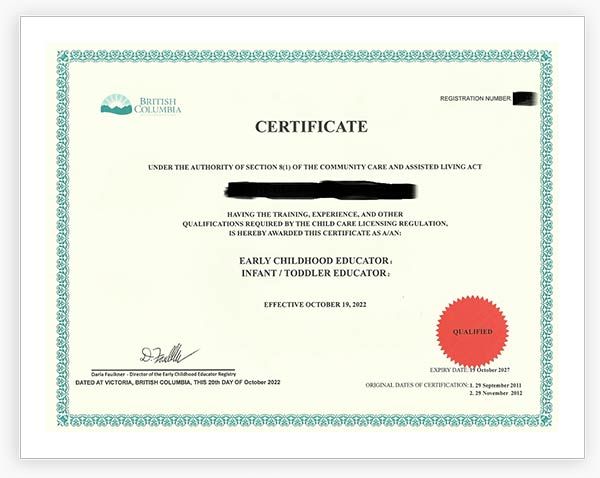
Photovoice discussions reflected how, within the turbulent and evolving landscape of ECL in BC, decisions are being made without input from the professionals in the field. While the changes are largely positive, they sometimes have unintended consequences, such as creating divisions between ECL professionals. Leading Change helped participants to understand the complex systems they are operating within and how to effectively speak up when policies don’t work. Participants shared that setting and enforcing boundaries can be uncomfortable initially but is necessary and gets easier with practice and support from their peers.
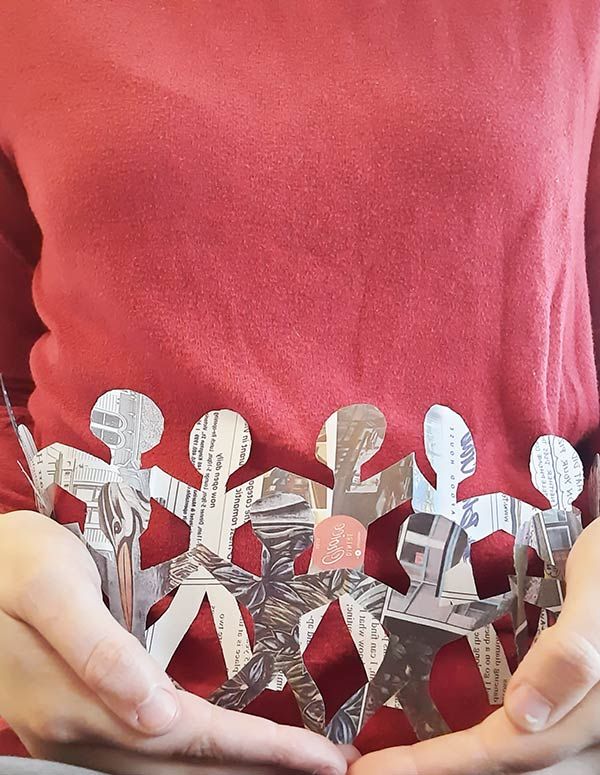
As educators when we speak to advocate, we are holding the voices of others. We have the responsibility to care for the children and families we work with and to fight for a better future for them and the ones that come next. It is not something we take lightly and it should not be taken lightly by others. Every fight for people’s rights is our fight because we care for all kinds of people.
Newsprint represents the thoughts of the people we hold as we advocate.
Project #6: ECEs for Inclusion in BC
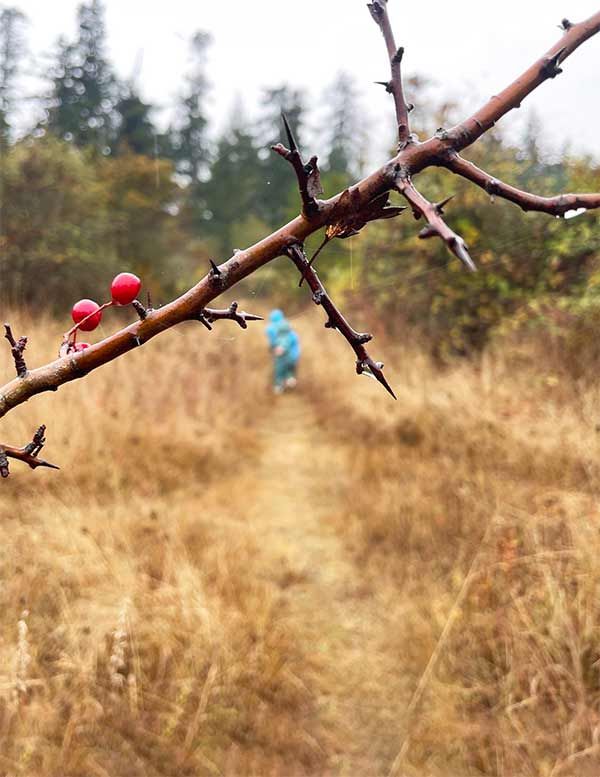
Children are already born with a great connection with nature; they do not get tired of seeing a pebble falling into the water, they will find the smallest shells or even find the wonder in an earthworm in the wet earth. As adults, we must provide moments where this connection can be nurtured since our life depends on the nature around us.
As educators, we encounter several challenges in making these opportunities possible and need the support of decision-makers. We need everyone to work so that this relationship develops and does not end at the end of each of their school days.
So even with the thorns in the way we need to trust that children know the way.
Project #13: Re-connecting with your Roots
There are many programs involved in shaping the ECE leadership field like there are many roads or streets in a city. No matter how big or small the road is, it is important and helps to reach their destination. On each road, there are a variety of different vehicles, motorbikes, bicycles, and pedestrians. They all must share the road.
On the map of the ECE field, one of the roads/streets is the ECEBC Leading Change. The Leading Change project allows many ECEs from all over BC to “share the road” in a welcoming, respectful, and creative way.
In many “vehicles”, forms, and ideas, LC facilitates sharing the road of change and leadership. It facilitates every ECE’s strengths, gifts, and potential. It facilitates connections, relationships, and space for disequilibrium. It facilitates the empowerment of each individual early childhood educator and the collective power of the ECE field!
Project #4: Finding your Why: Reigniting your Passion
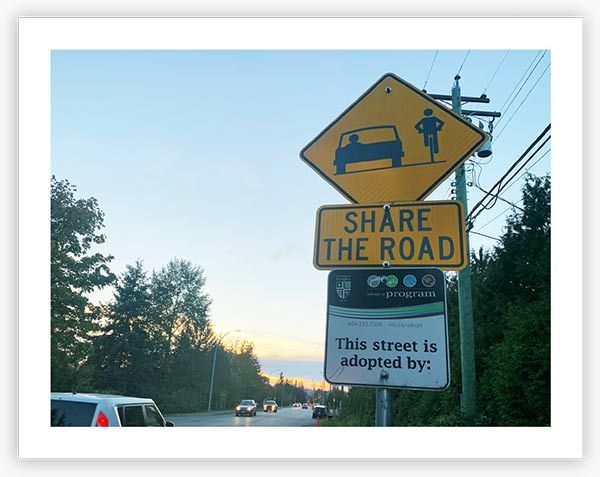
The early years workforce is strong and determined, even when presented with harsh conditions.
We are all intertwined and connected in the work we do, although some of the work is not visible. Through connection we are all stronger.
Project #16: Growing Relationships and Connections to the Land
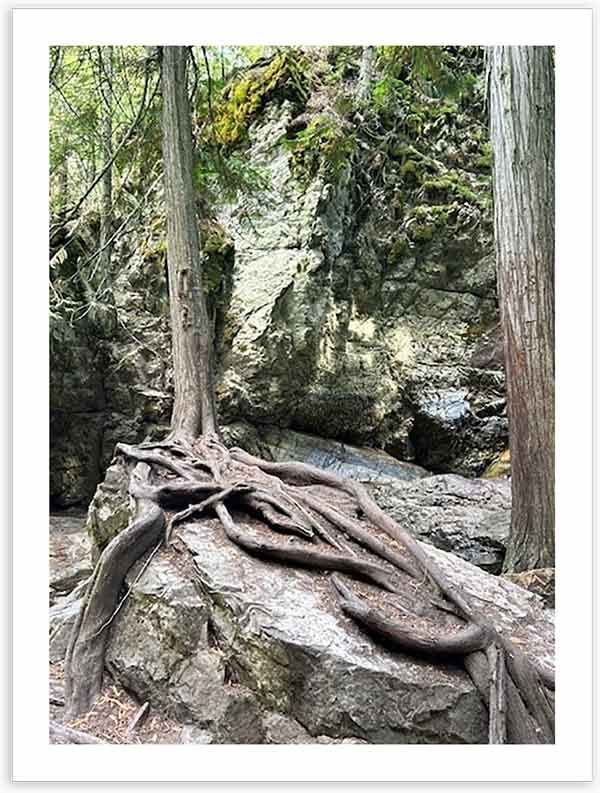
In this photo, all elements of nature appear beautiful to me, both the leaves changing colour as fall nears, and the flowers brightening summer’s conclusion. Educators too, are incomparably valuable to our field in different stages of their careers. The new grads, sharing the latest thinking, full of energy and optimism; the established colleagues, reflecting on their ongoing practice and emerging philosophy; and the wise, experienced leaders, holding many stories, and a great deal of insight.
The Leading Change program has provided opportunity for educator retention, pulling us out of routine, away from burnout, and into a community of like-minded educators filled with hope for the future of our field. The message that we all matter, that we work as a system, has been clear.
Project #6: ECEs for Inclusion in BC
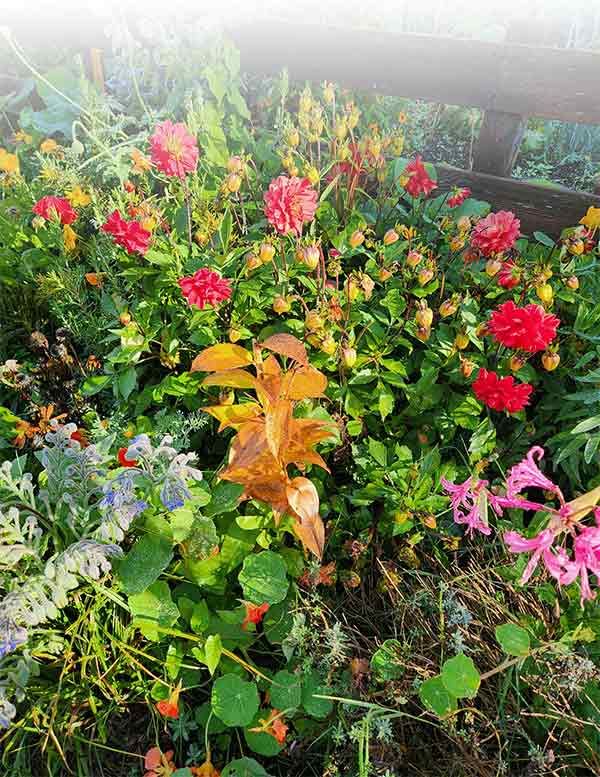
Through this project, participants reaffirmed that despite working in a changing, challenging system, ECEs are resilient and capable. Leading Change helped participants find their voices and a network of fellow changemakers across the province who are invested in furthering this important work. By reminding each other that their voices matter, they help one another persevere in the face of adversity and burnout. Participants in this program are now more aware of the issues that impact them and are emboldened to advocate for themselves, the children and families they work with, and other ECL professionals.
Children deserve happy, healthy, and qualified ECEs who are valued for their essential work. Lifting up ECE leadership is an investment in the future.
We appreciate the time and energy that Leading Change participants and program staff put into this Photovoice project. Participants engaged with the enthusiasm, vulnerability, and thoughtfulness that we have come to associate with early care and learning professionals; their insight and passion was invaluable to this project, much as their work is invaluable to children and families.
This project took place across what is now referred to as British Columbia. We recognize the more than 200 Indigenous nations whose ancestral and stolen land makes up this province, and the ongoing reconciliation work that is needed within the area of social research.
- Pathways of Truth: this initiative explores truth and decolonized practices in early education through critical reflection and dialogue.
- Connections through Self Compassion: focuses on well-being and professional self-care through ethical dialogues in rural settings.
- Mentorship Initiative for ECE Dual Credit Students: aims to provide high-quality mentorship and resources for Dual Credit ECE students.
- Finding your Why: Reigniting your Passion: focuses on reigniting pedagogical leadership and professional passion through workshops, values based explorations, and story-sharing.
- ECE Retention: Solutions from the Field: A project that surveys ECEs to understand the impact of a lacking substitute system on retention.
- ECEs for Inclusion in BC: aims to gather and report data on inclusivity practices within early education.
- ECE Advocacy: focuses on community dialogues and advocacy to address local childcare needs on their Island.
- Mindful ECEs and Mindful Minis: promotes mindfulness practices to boost well-being and community connections among ECEs, children and families.
- The Story That Made Us: Empowering Identities of Early Years Professionals: leverages virtual gatherings to celebrate and uplift the identities of the Canadian Filipino ECE community.
- Evergreen Movement for ECEs: project leaders held a community gathering aimed at fostering support and collaboration among ECEs in remote communities.
- Nurturing our ECE Community: workshops aim to re-connect ECEs and explore opportunities for long-term collaboration.
- Supporting Indigenous ECEs: hosts virtual fireside chats to explore cultural traditions and practices among Indigenous ECEs.
- Re-connecting with your Roots: promotes integrating cultural diversity and ancestral knowledge into ECE practices.
- Voices of Immigrant Child Care Professionals: showcases the journey and challenges of immigrant women working in the ECE sector, advocating for wage enhancements and supports.
- Seeds of Hope: uses storytelling to spotlight sector challenges, strengths, and hopes through ECE community dialogues.
- Growing Relationships and Connections to the Land: engages ECEs to strengthen consideration of work towards Truth and Reconciliation through connections to land and Indigenous knowledge.
- Immigrant Voices in Early Learning: gathers narratives from newcomer parents to advocate for inclusive practices in early education.
- Igniting a Circle of Compassion: explores compassion as a tool for family connections among ECEs, leveraging various ethical frameworks.
- ECE in Rural BC: A podcast series that illuminates the unique challenges and rewards of being an ECE in rural areas.
- The Joy of Child Care: a series of workshops designed to renew connections and share new resources among ECEs.
- Possible Pathways for Educators: a resource book sharing experiences to foster collaborative partnerships within Seamless Day programs.
- Spaces of Inclusion, Well-being, and Belonging: aims to create sensory-sensitive spaces for enhanced well-being and collaboration among educators.
“Photovoice may provide an effective and vivid way for people to show firsthand their perceived strengths and needs, to promote critical dialogue and knowledge about their community’s assets and concerns, and to reach policymakers through images and stories of everyday life to bring about change. It exploits the emotional power of photographs produced by people who carry a particular authority in what they choose to describe. It is designed to increase the individual’s and the community’s access to power
(Wang & Burris, 1997, p 382)

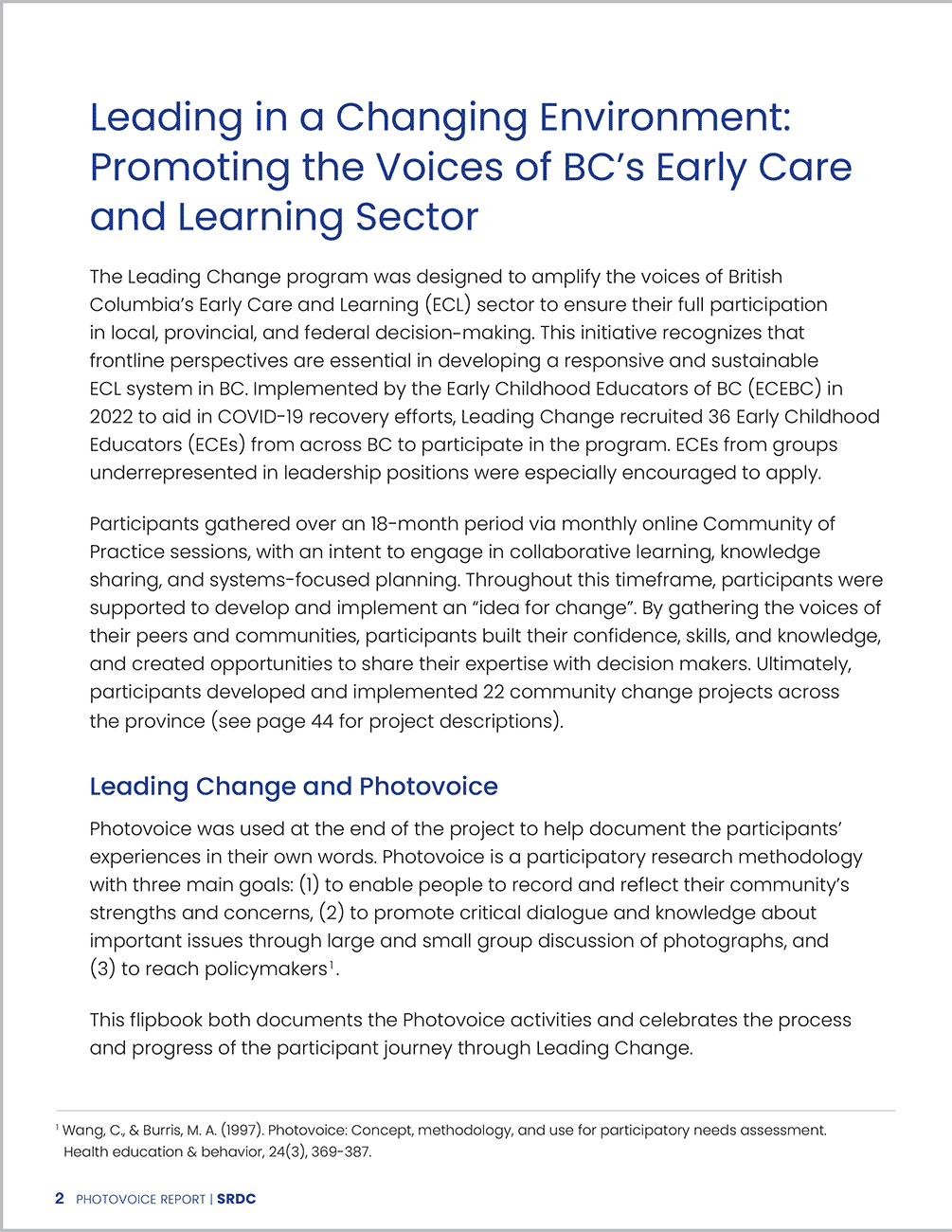

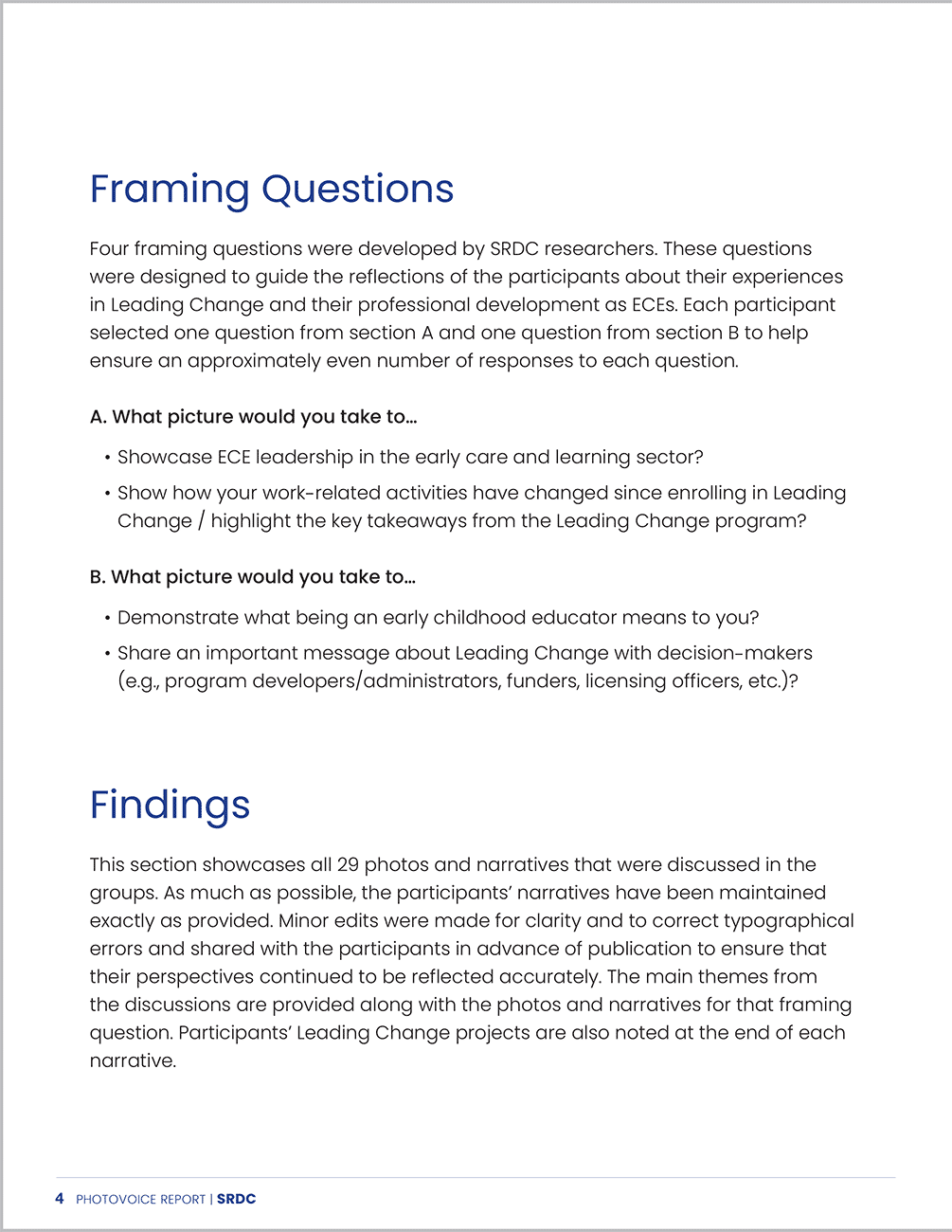
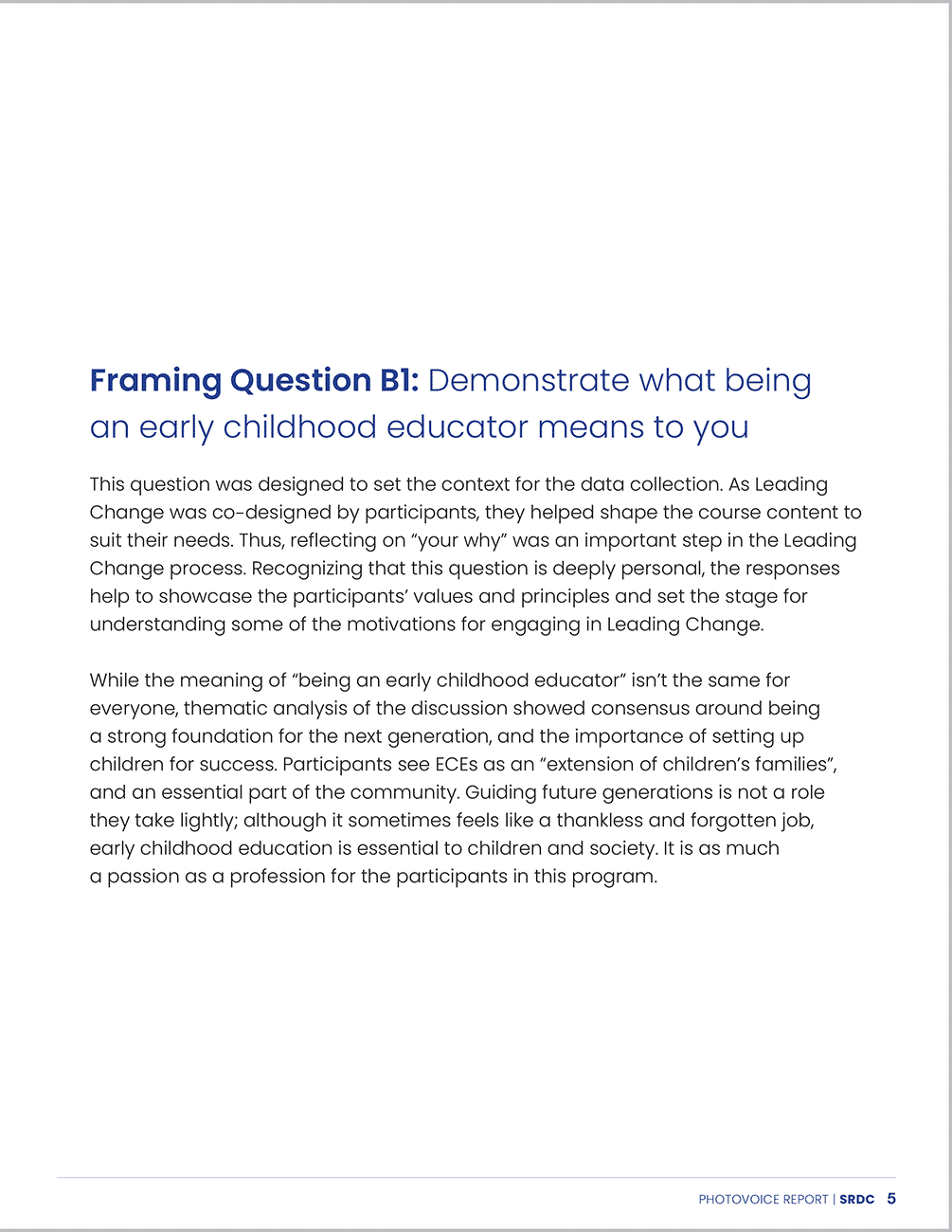
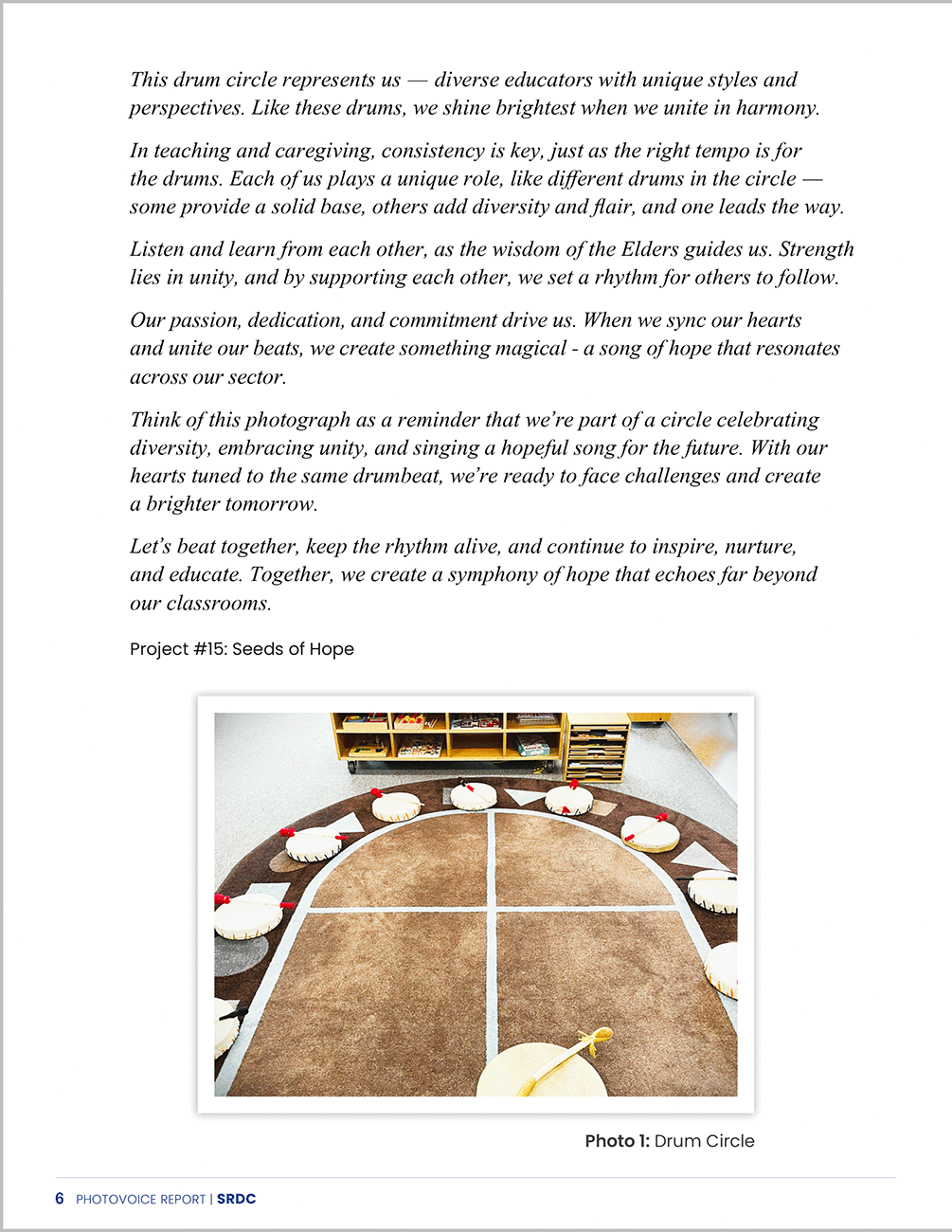

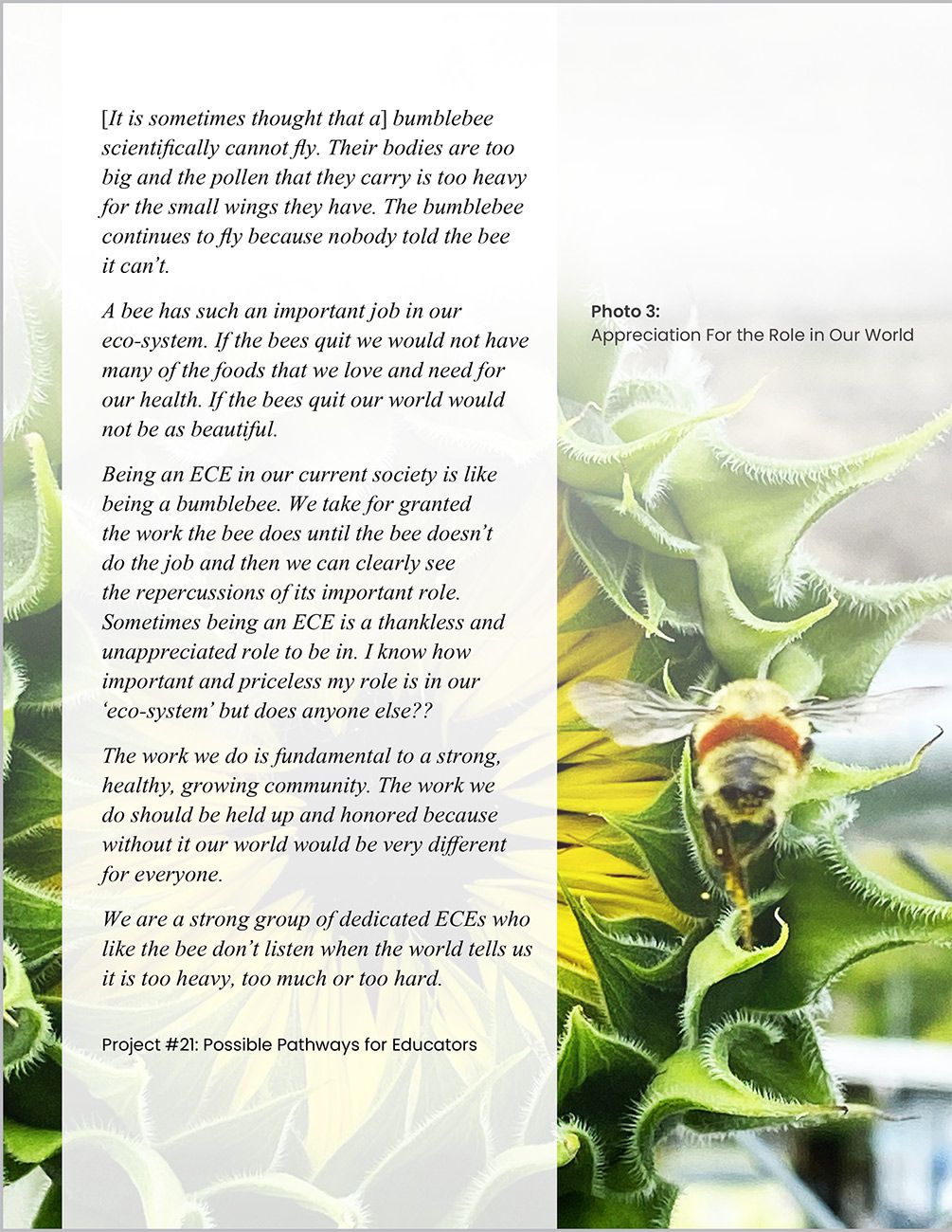

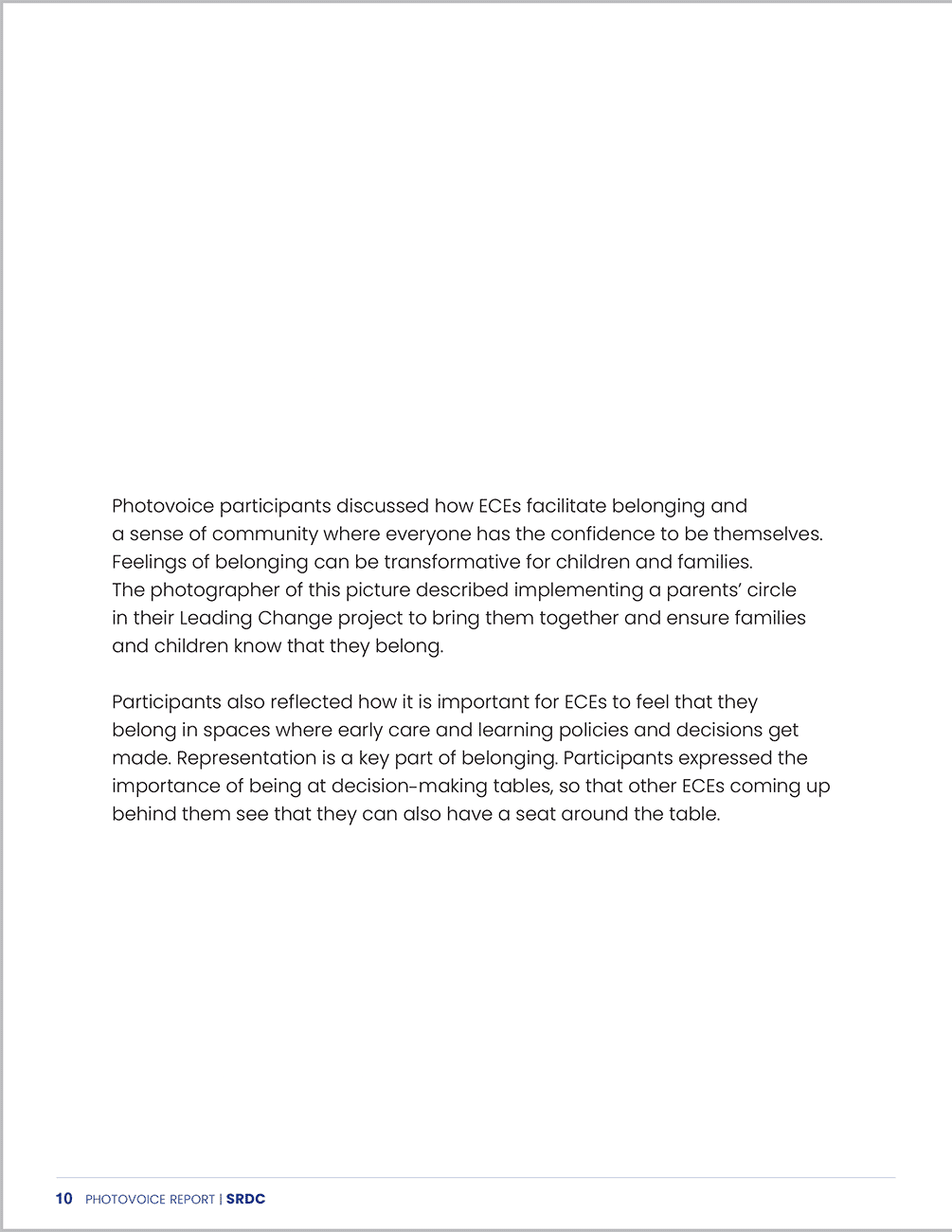
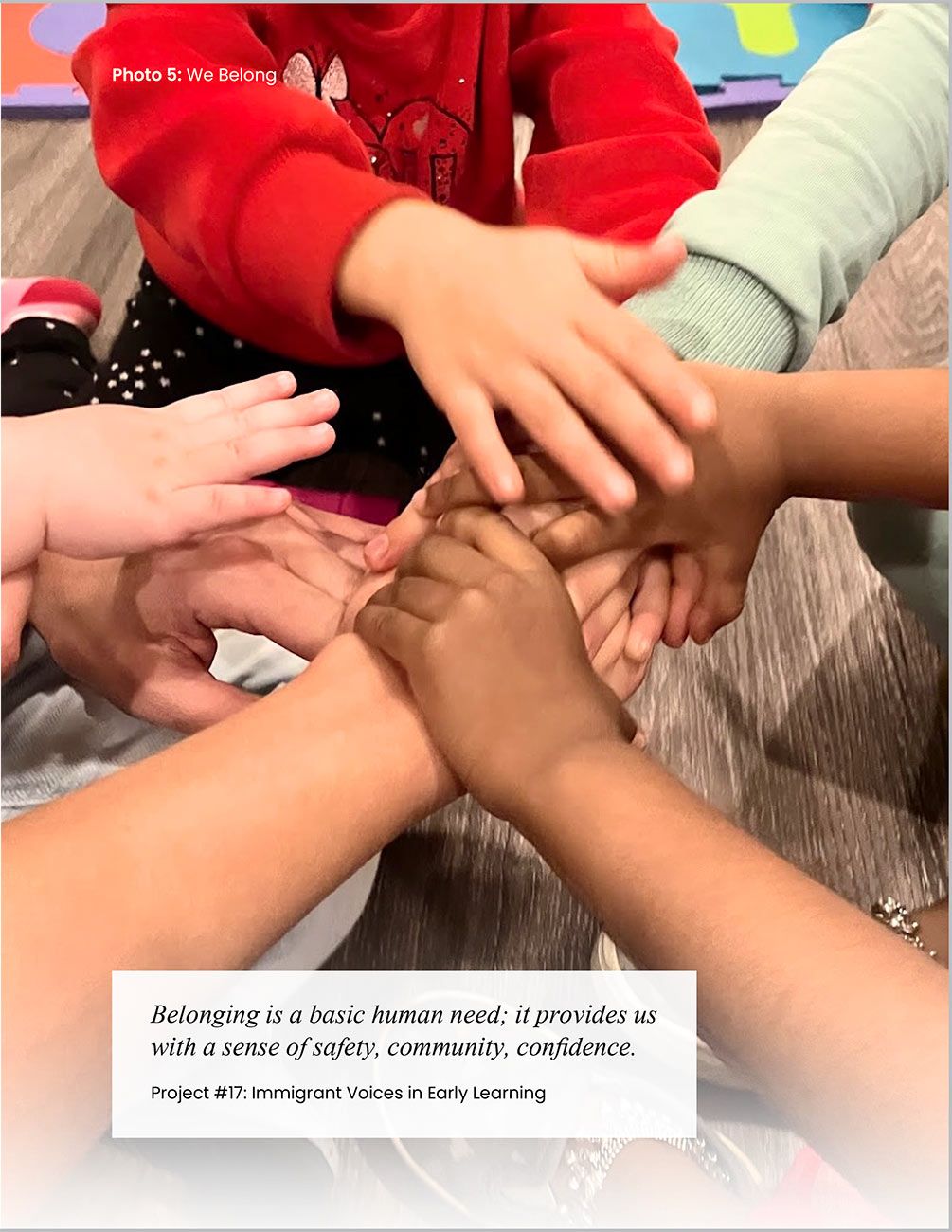
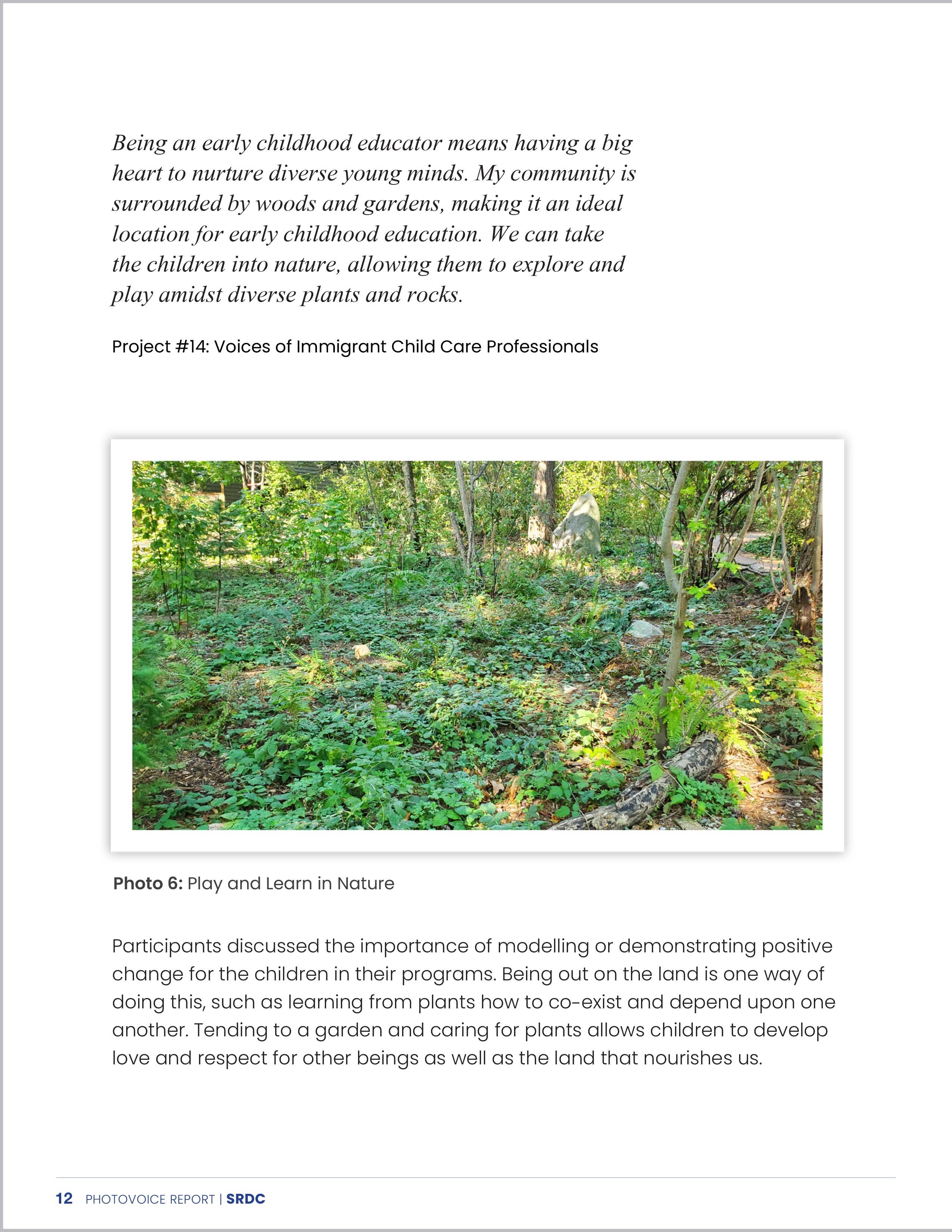
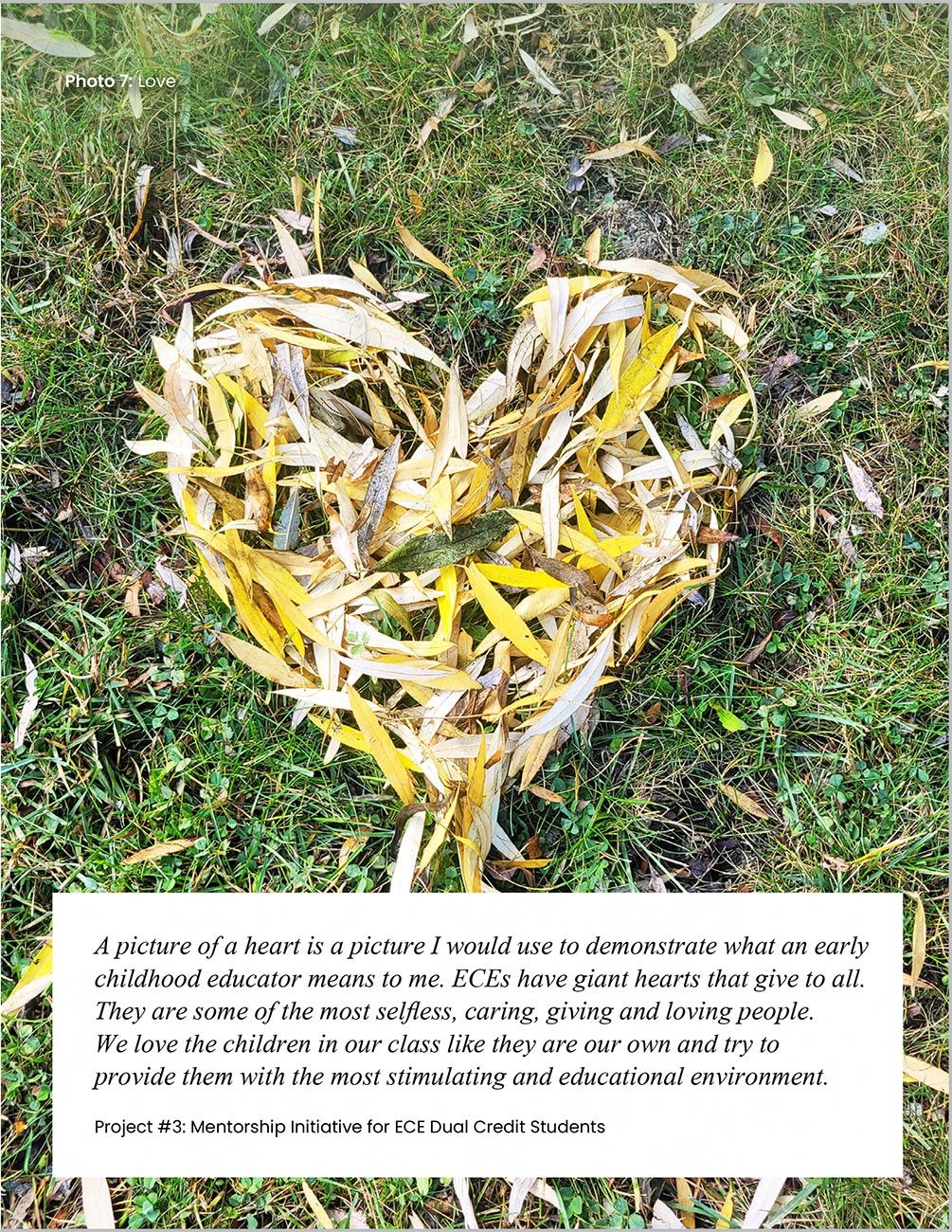
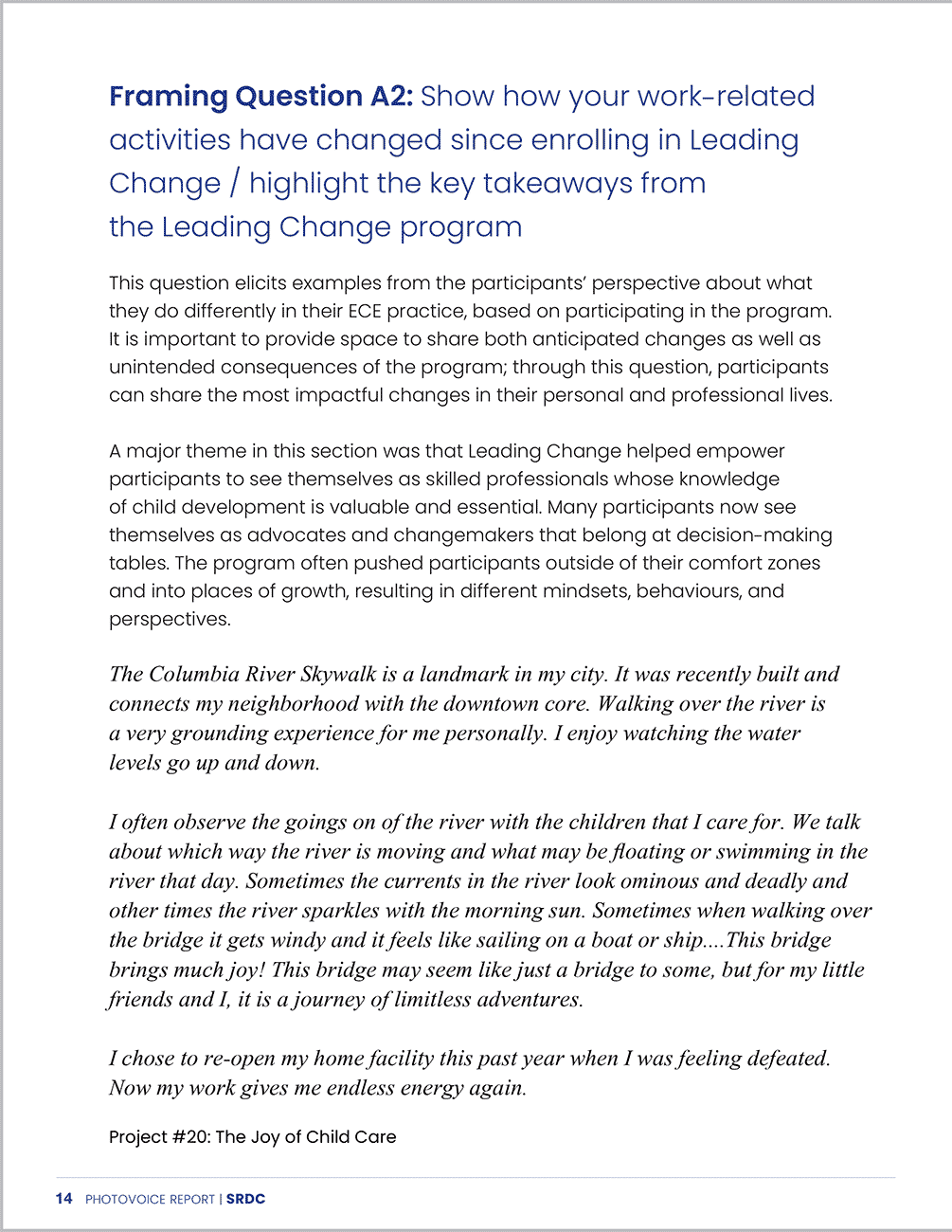

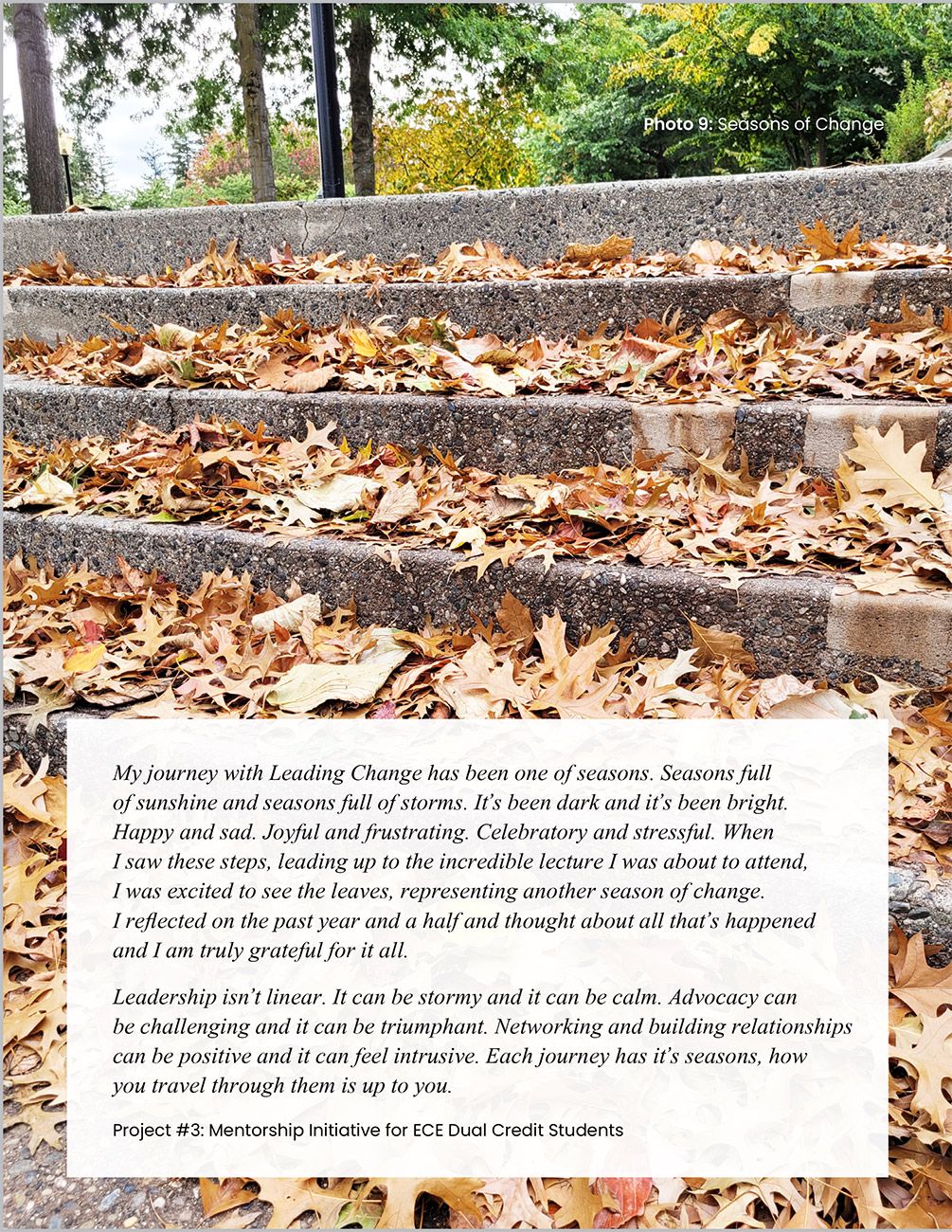




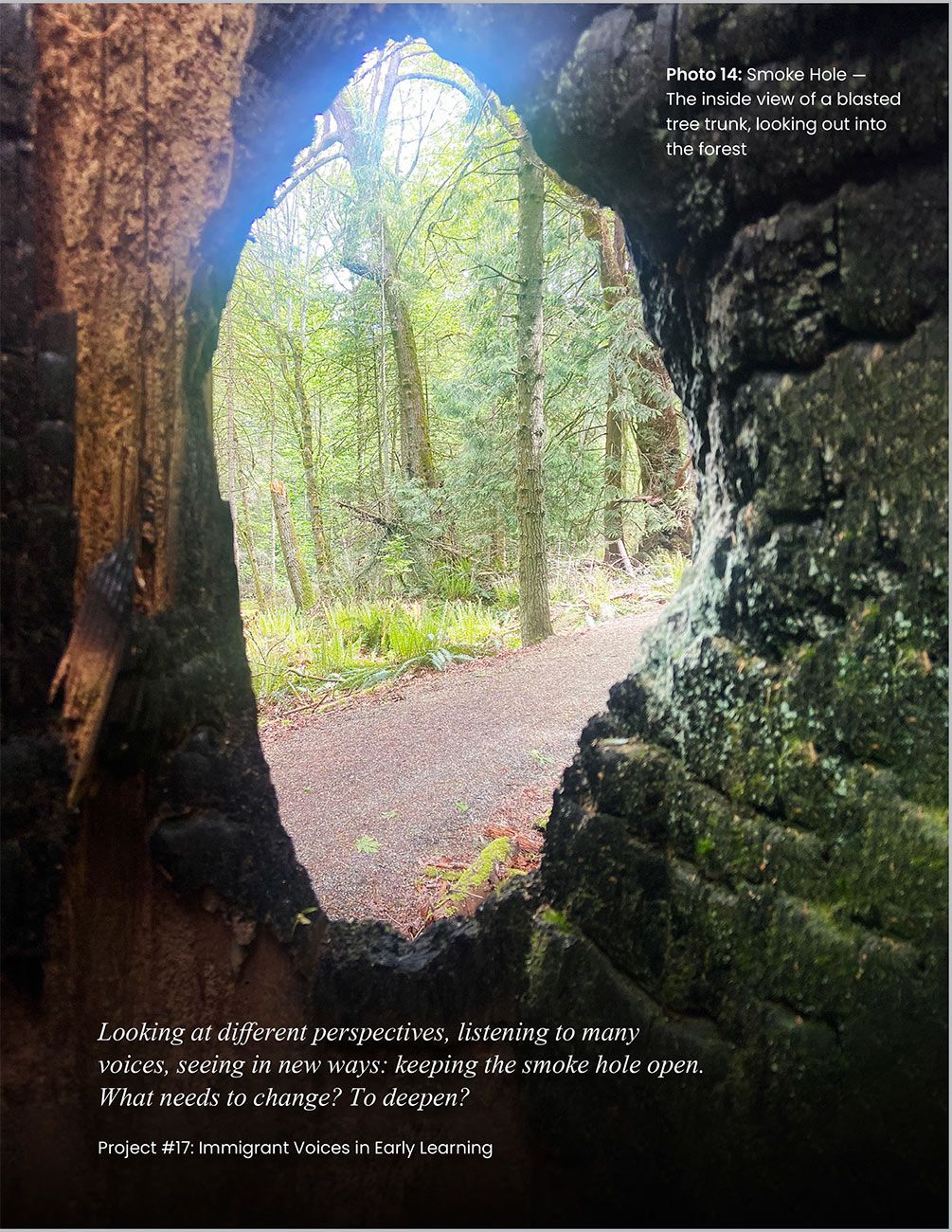



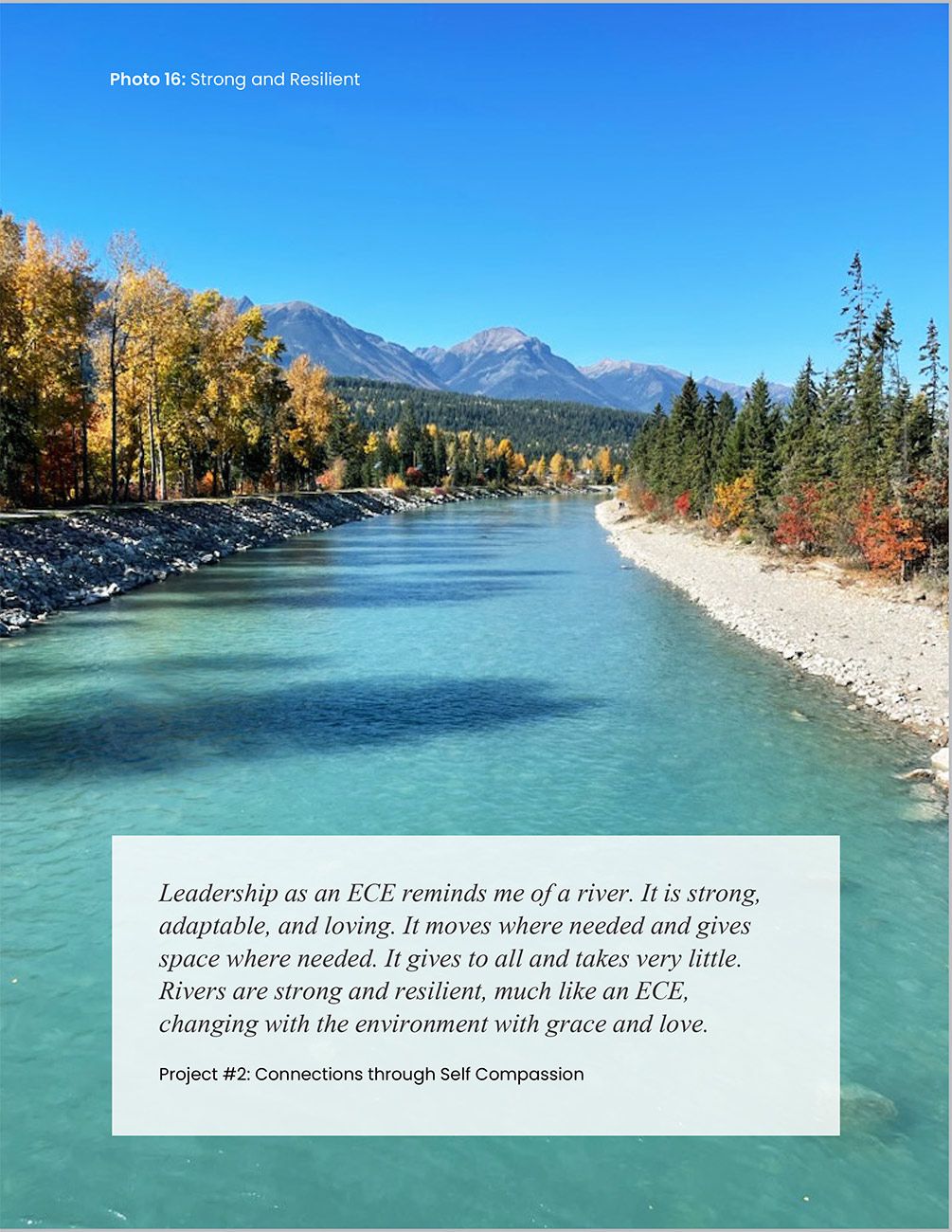
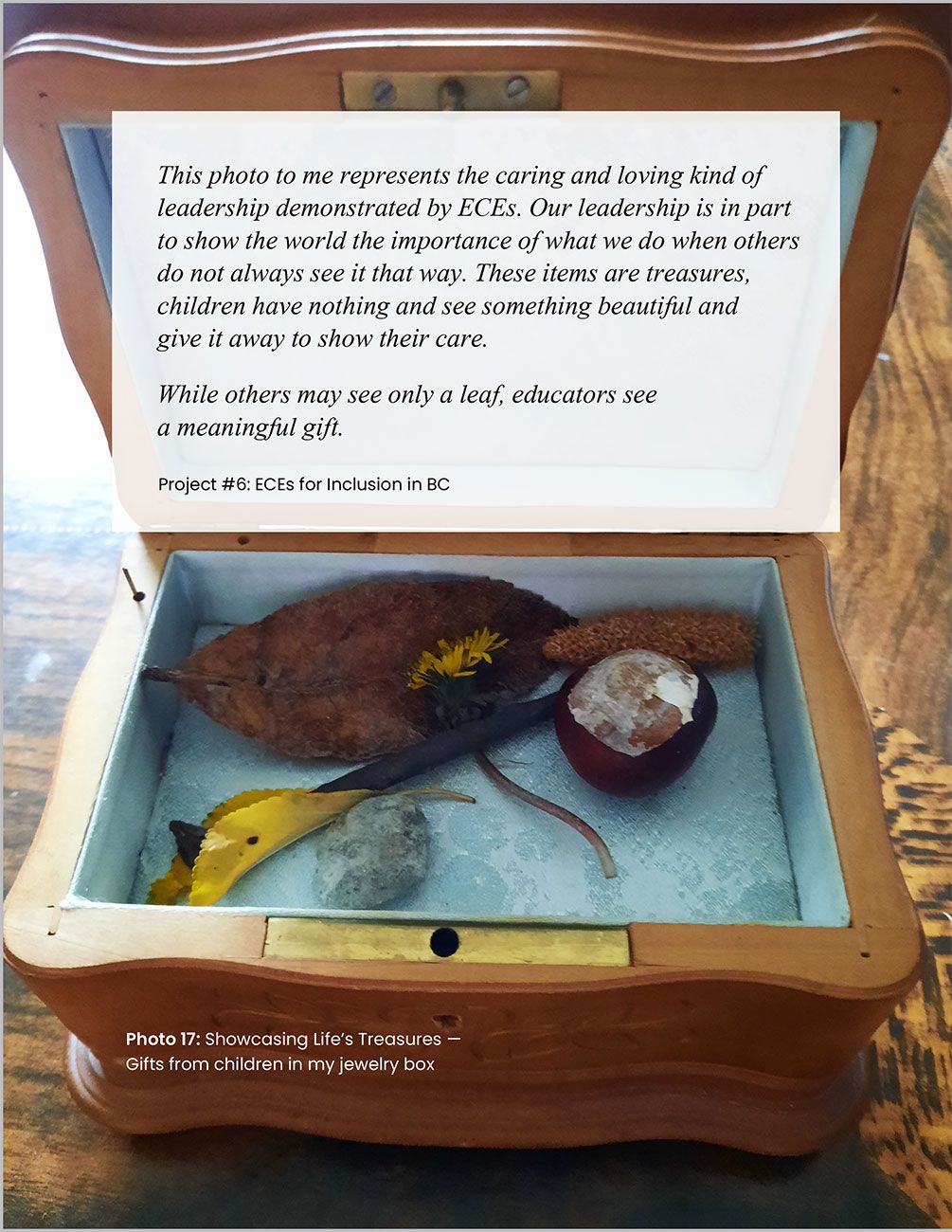
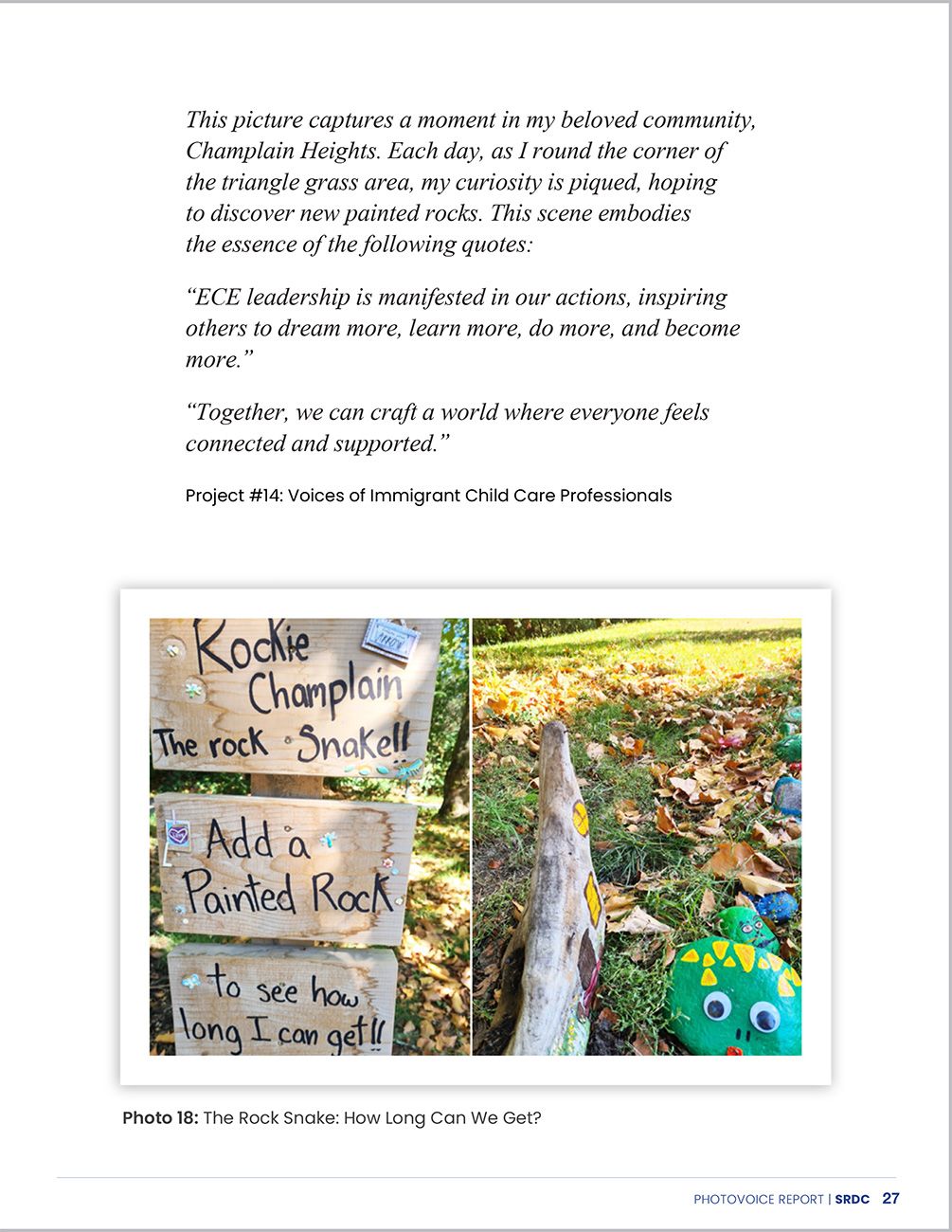
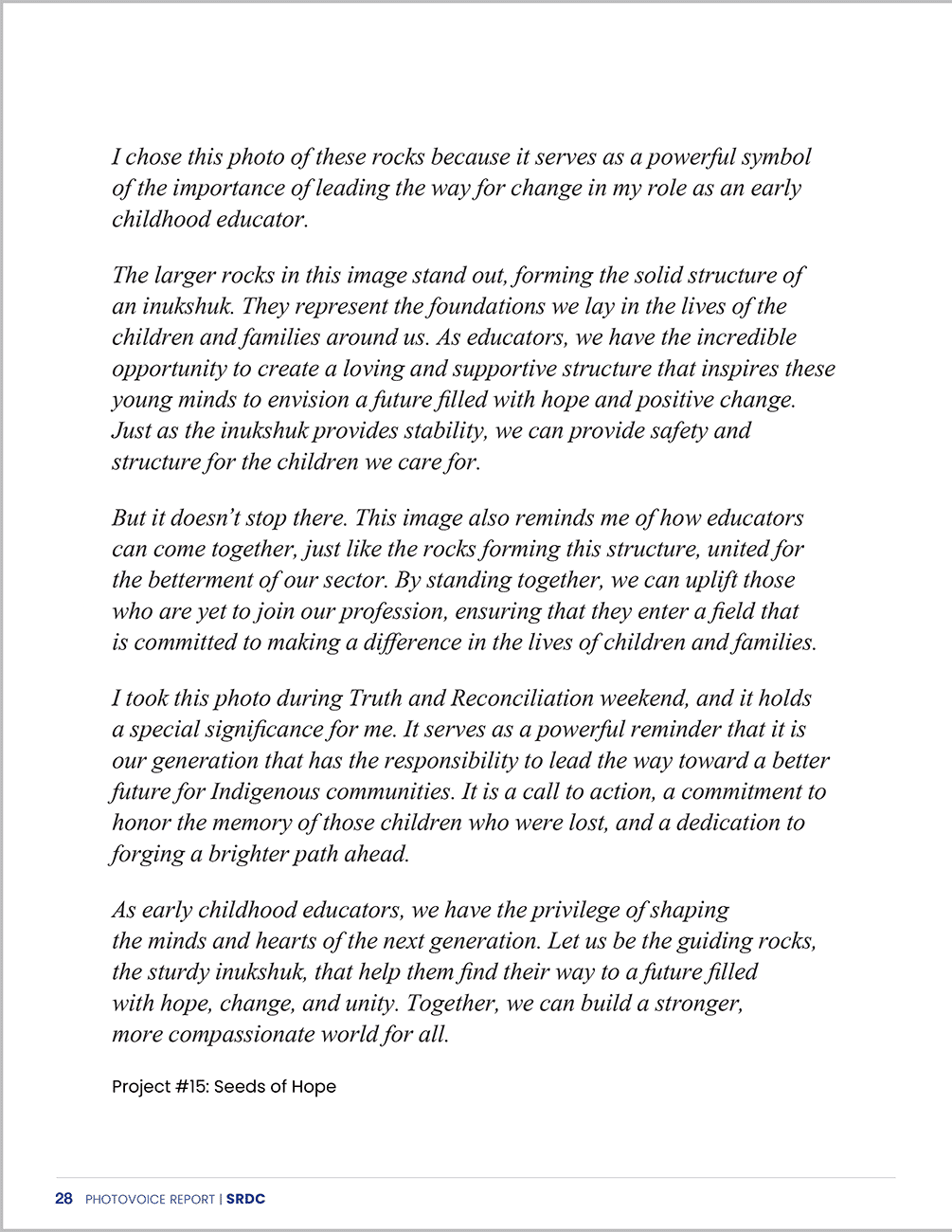
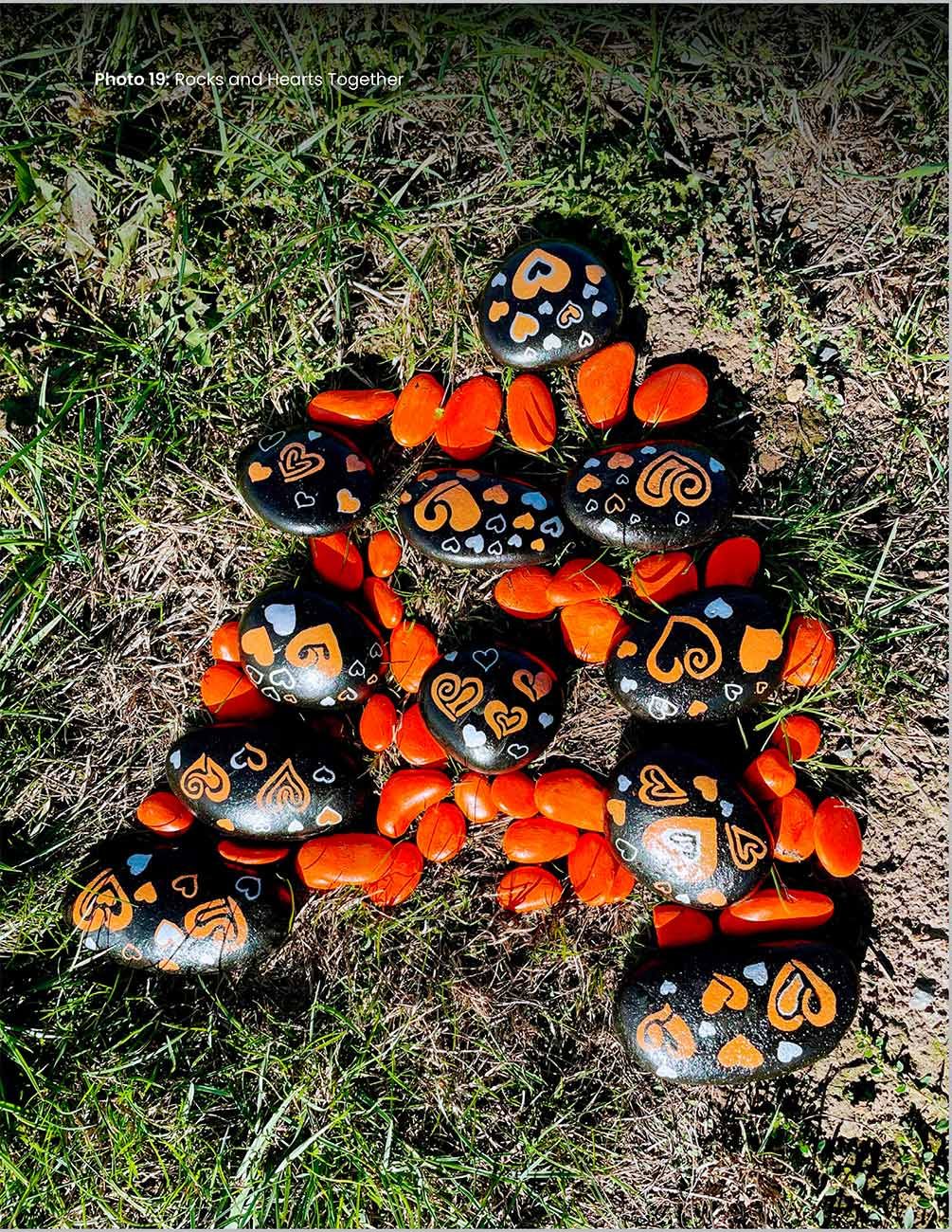
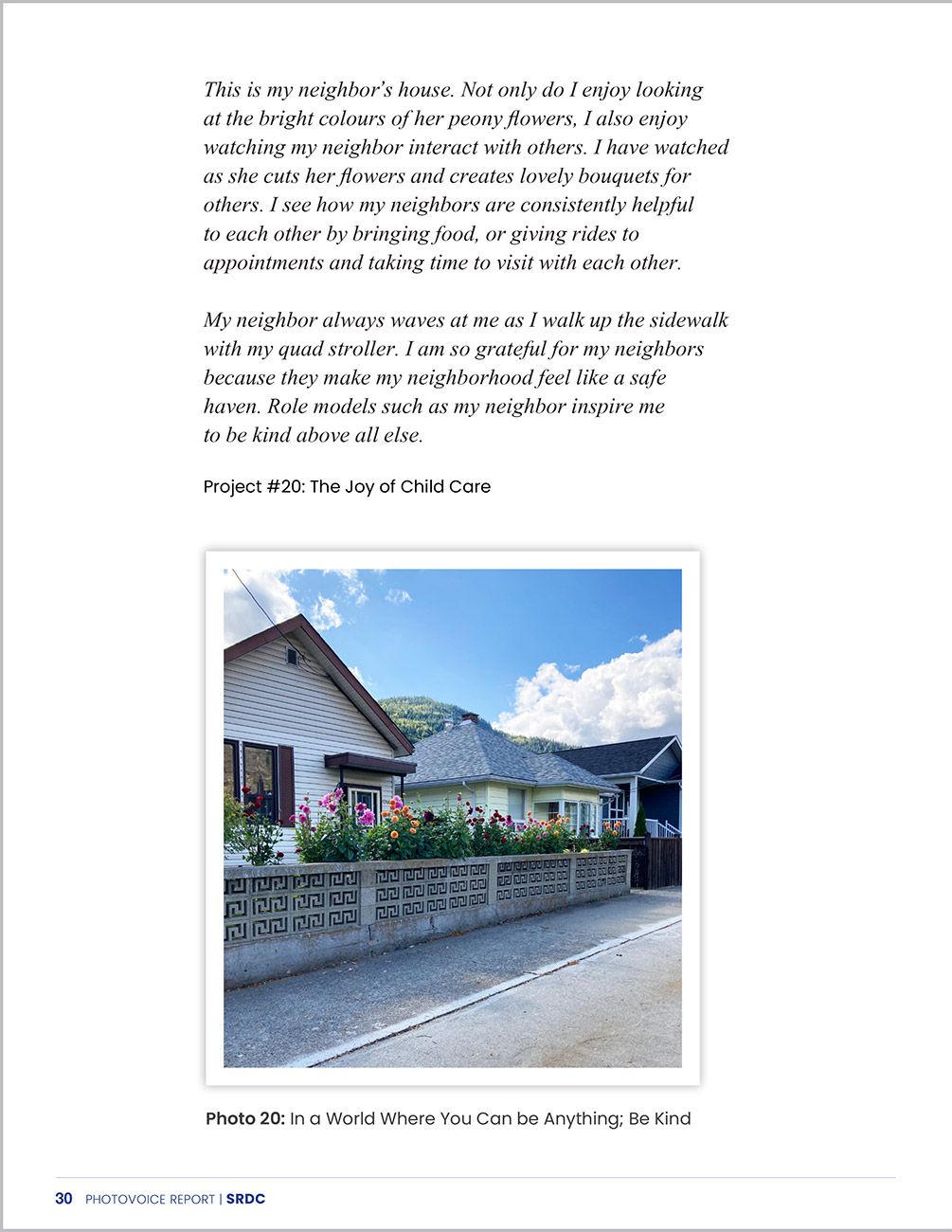
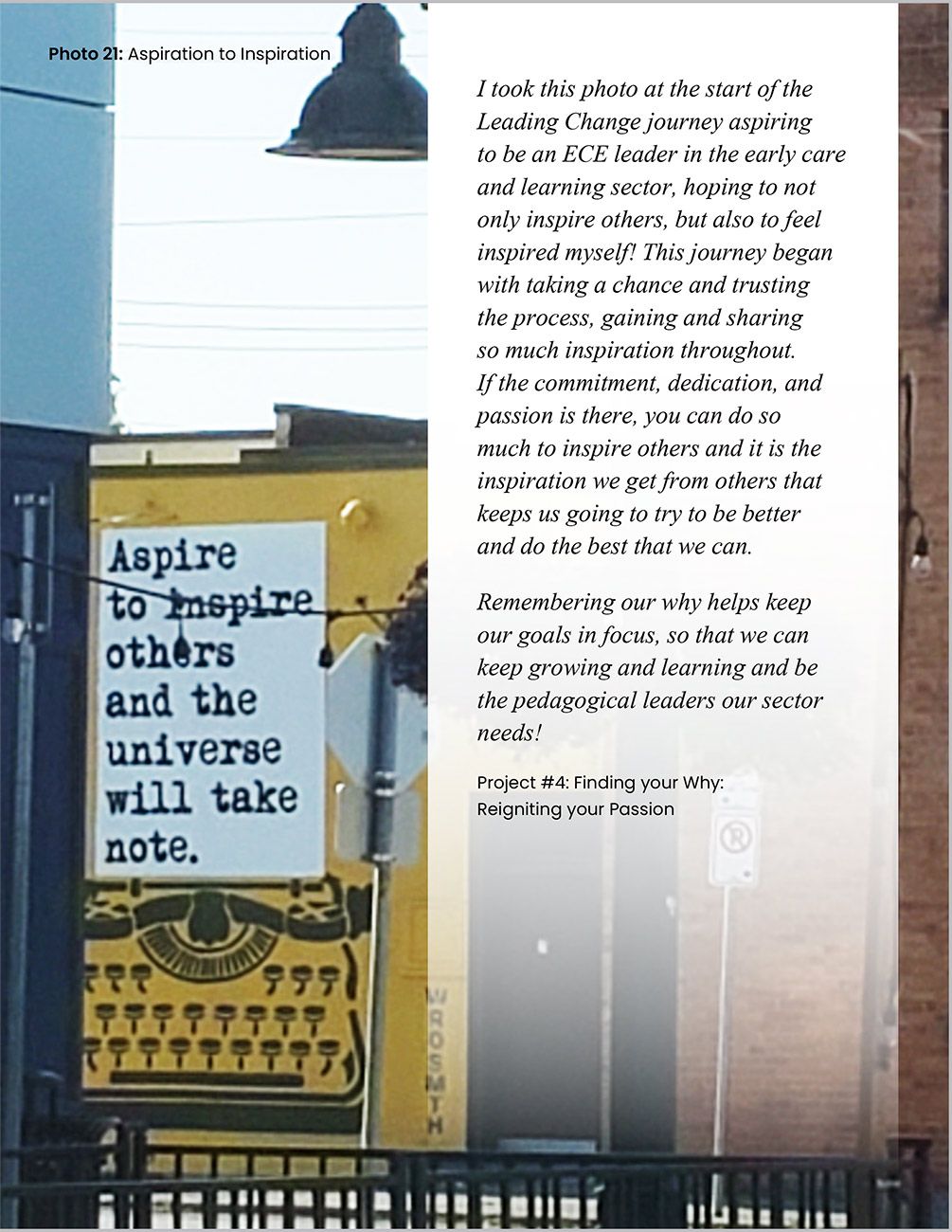
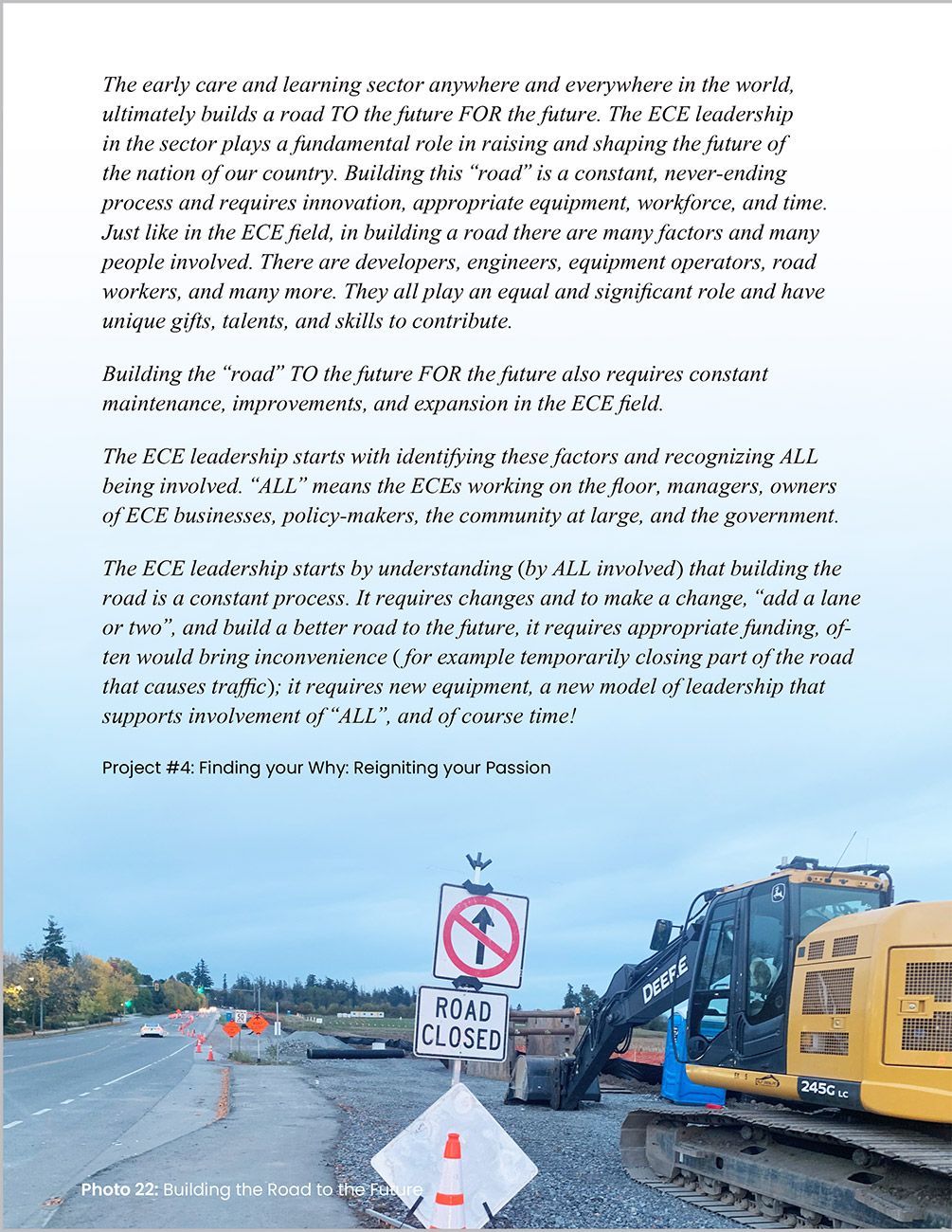

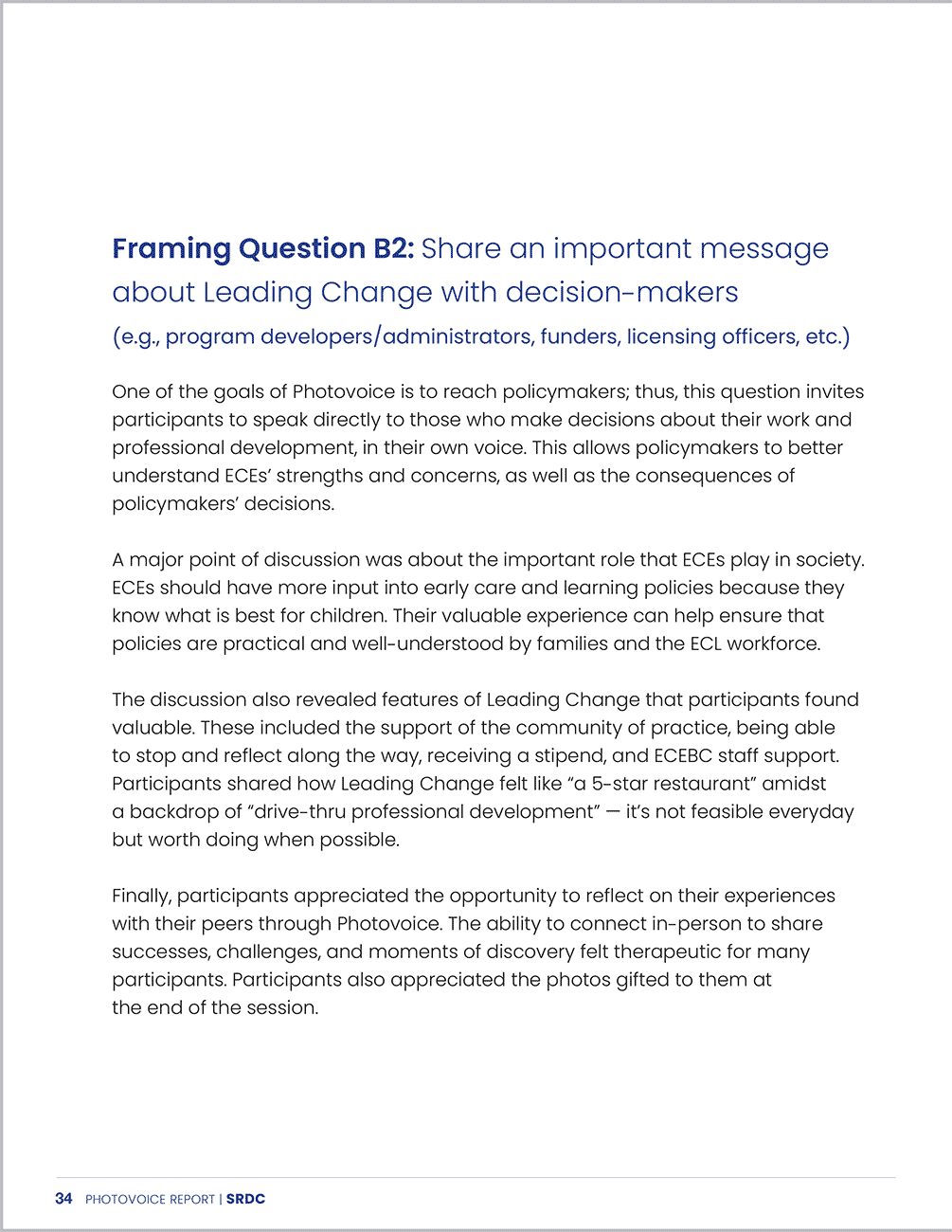
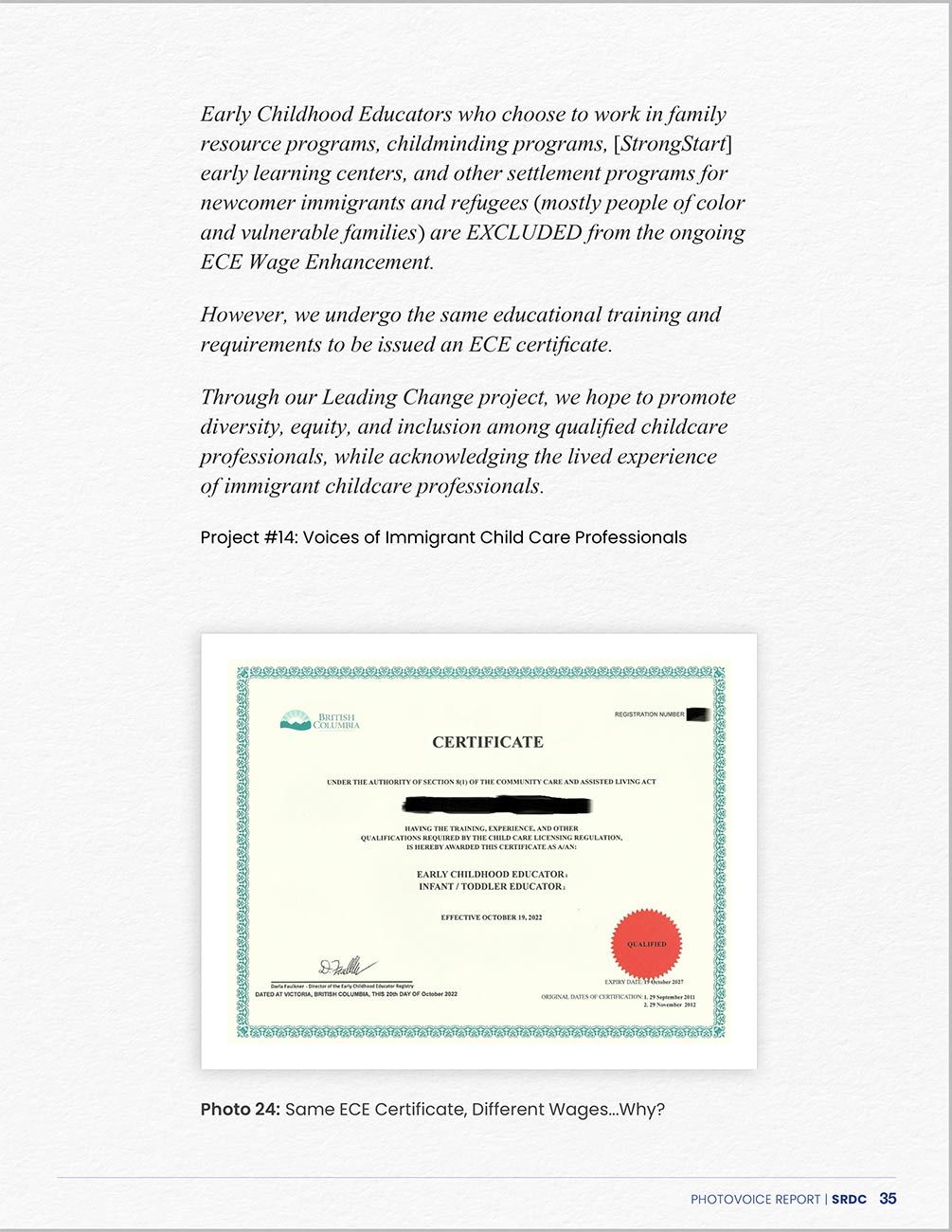
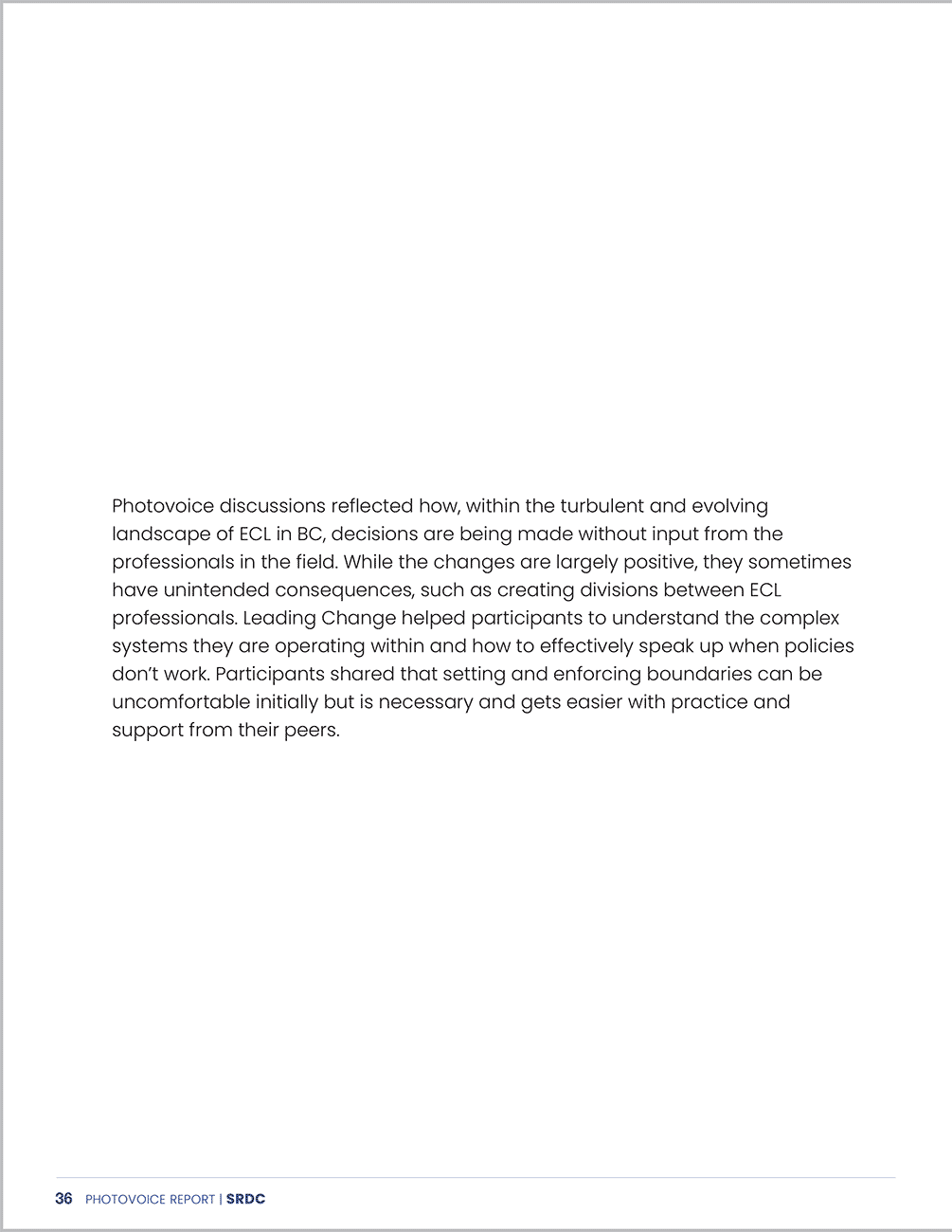
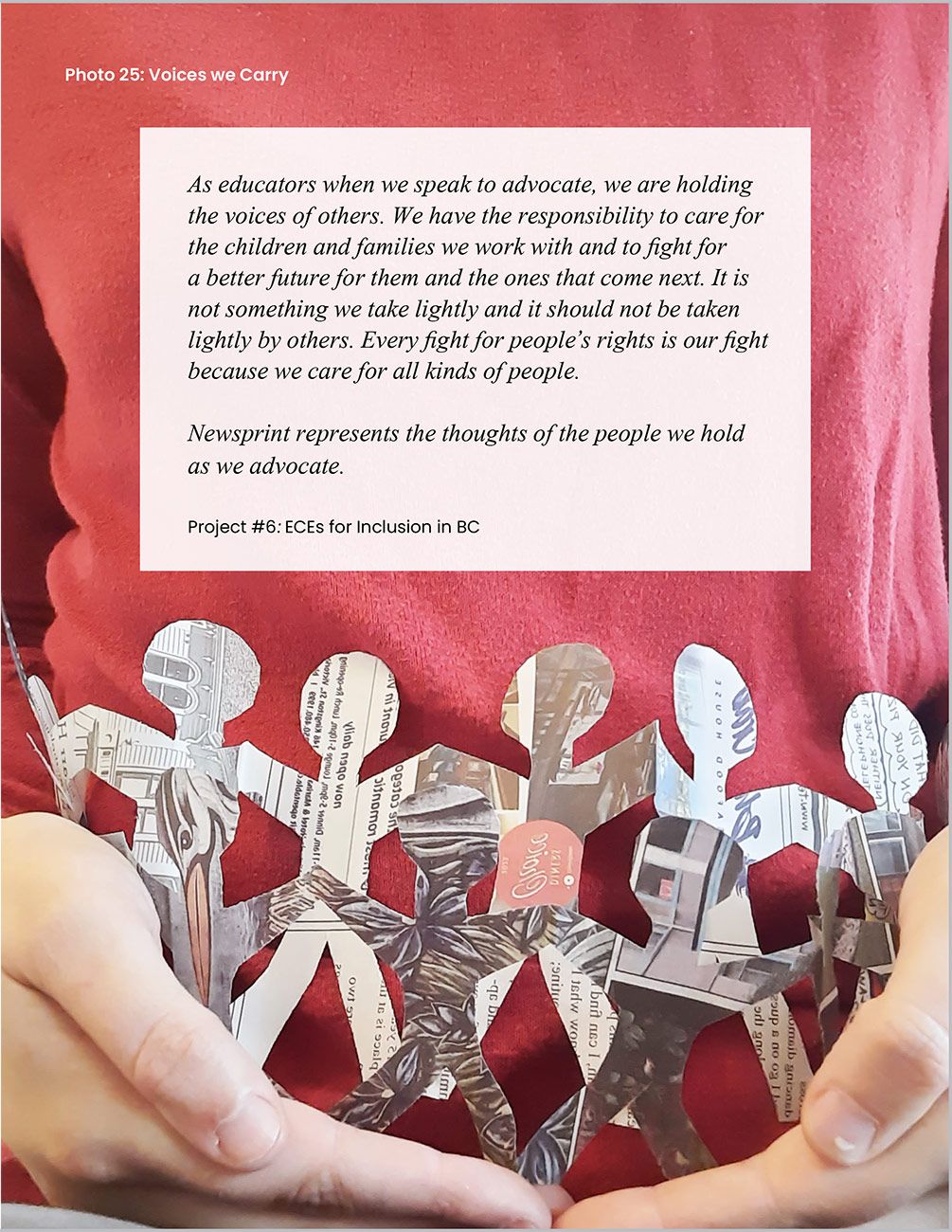
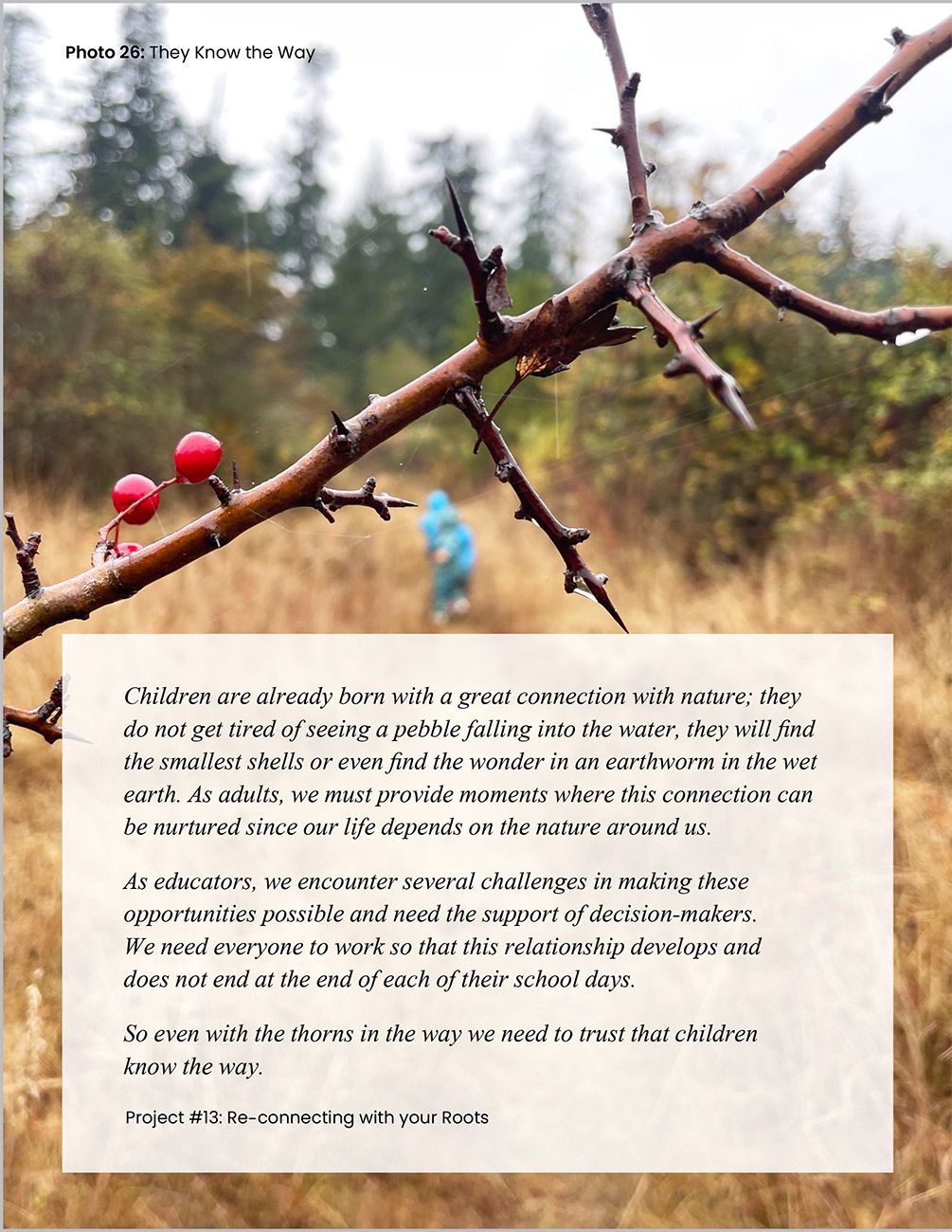
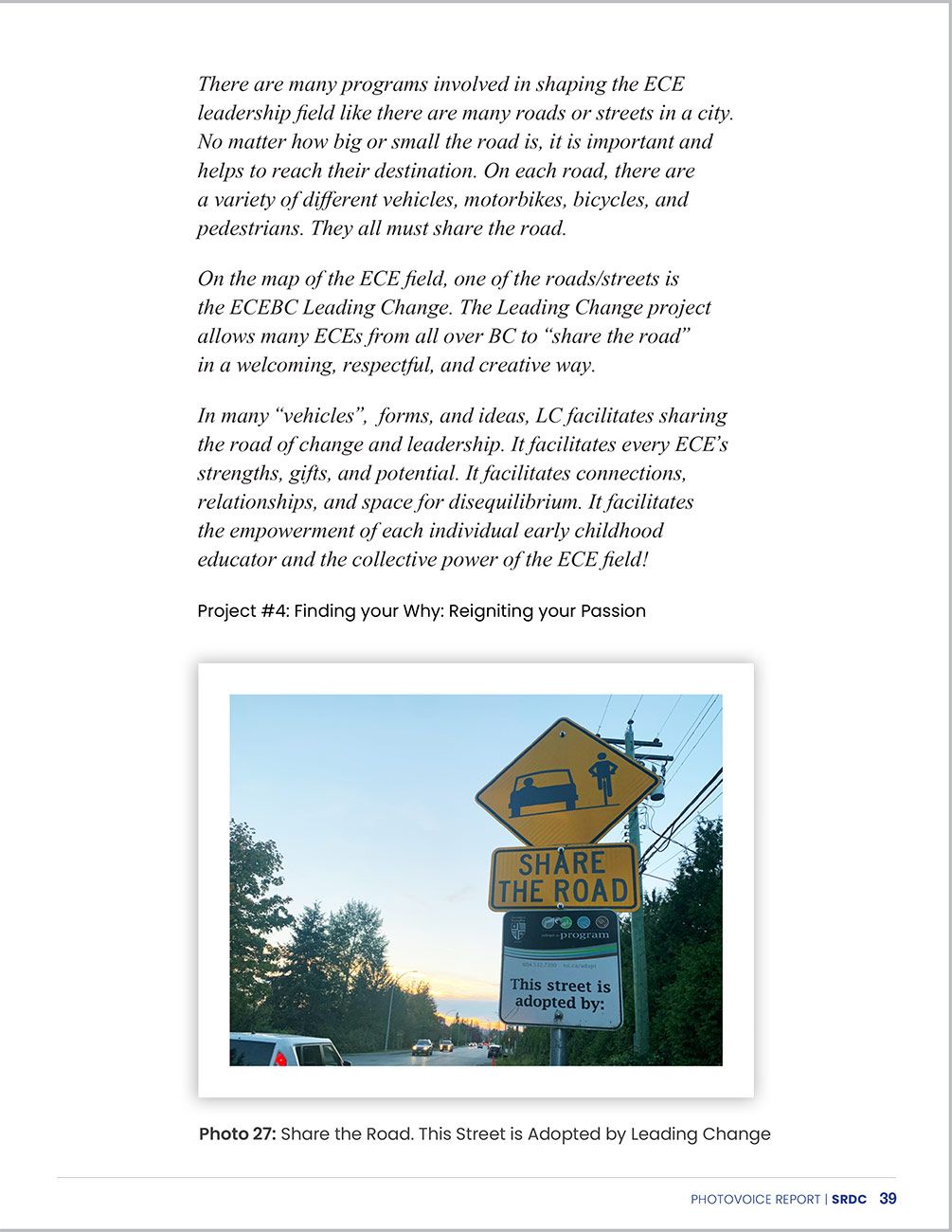



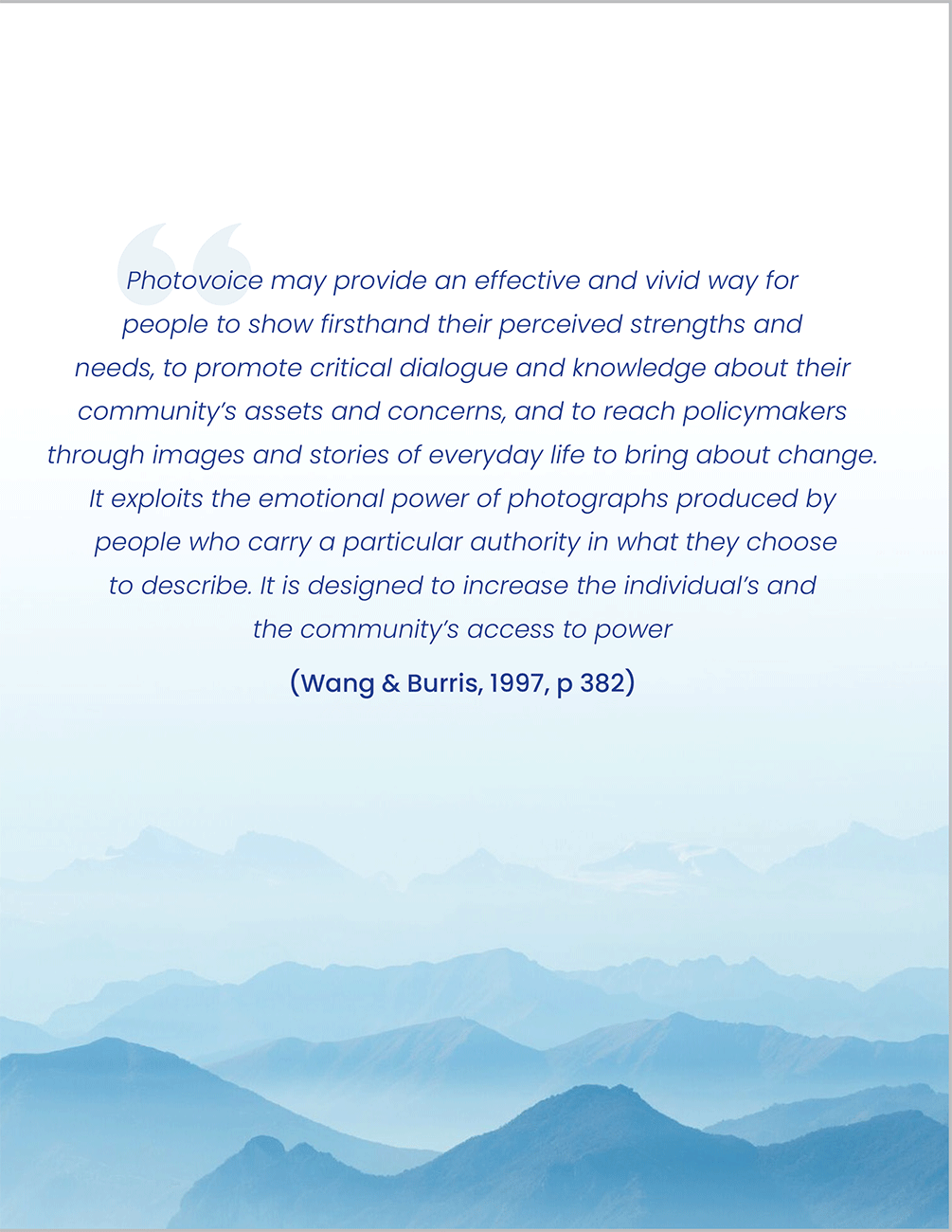
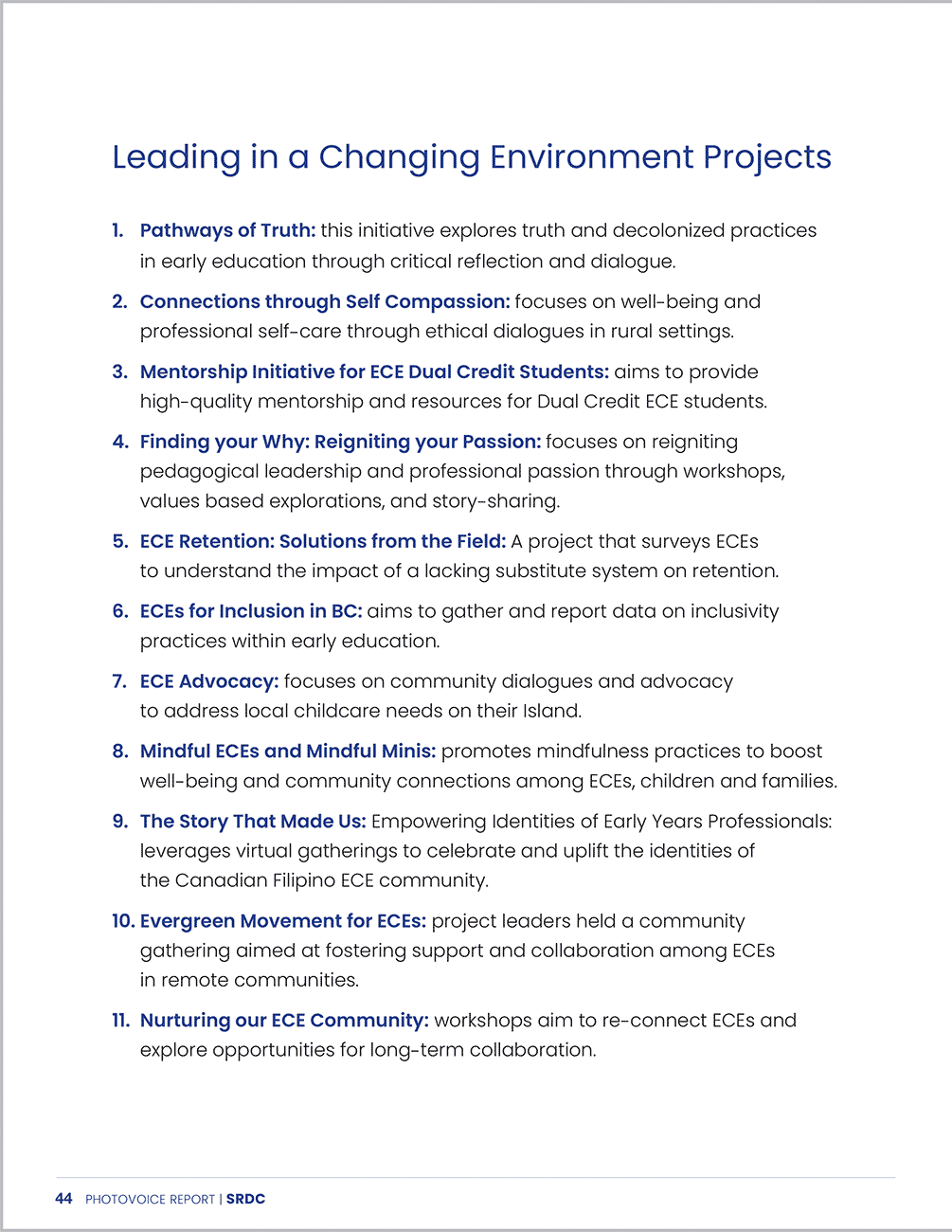
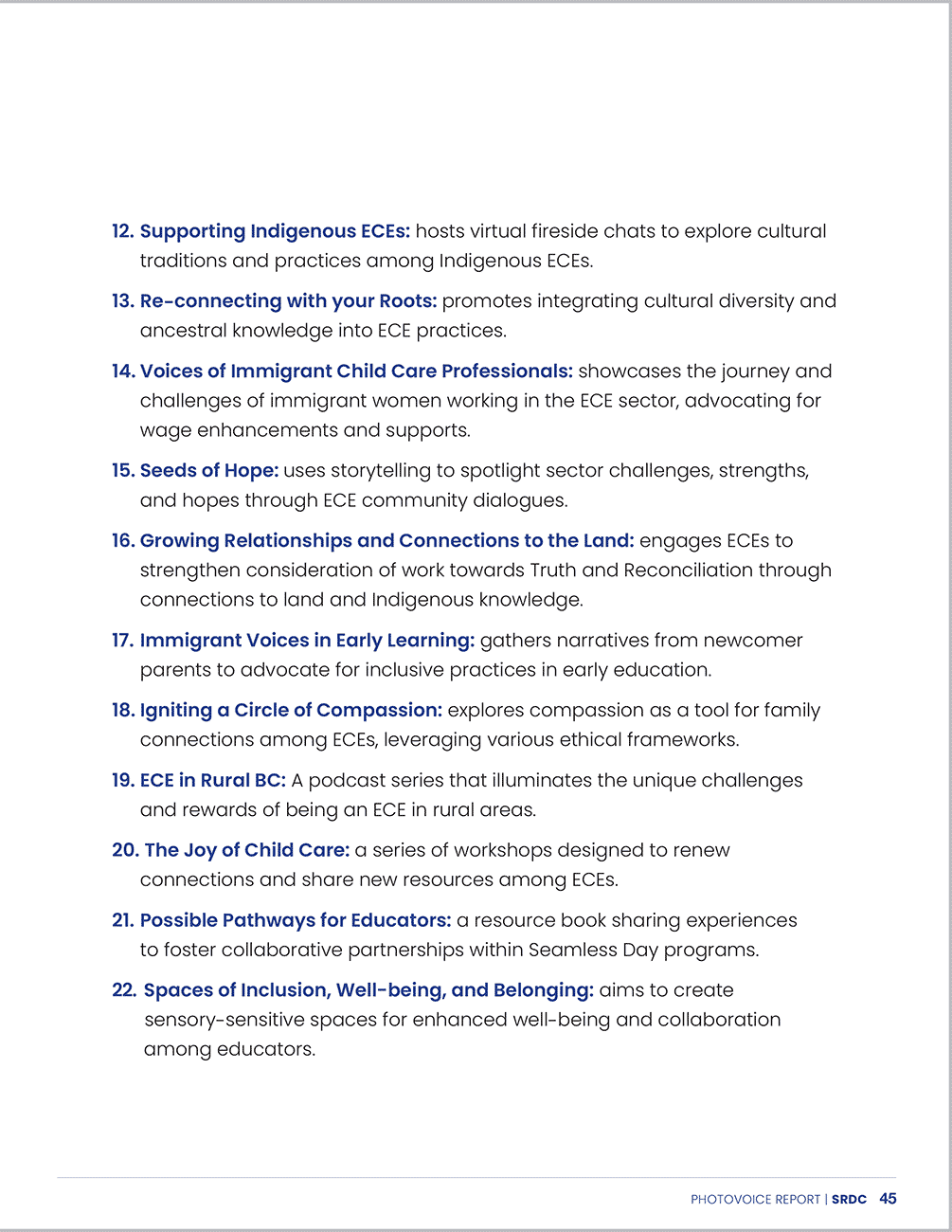

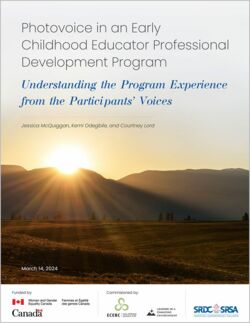 Photovoice in an Early Childhood Educator Professional Development Program
Photovoice in an Early Childhood Educator Professional Development Program 